lordroel
Administrator
Posts: 68,061 
Likes: 49,462
|
Post by lordroel on Feb 15, 2023 3:53:17 GMT
Day 1619 of World War II, February 15th 1944Eastern Front As the situation in the north and south continues to deteriorate, Hitler allows Heeresgruppe Center to withdraw to the 'Panther' Line. He also, grudgingly gives permission to attempt a breakout from the Korsun pocket. Air War over Europe After a rest of more than 2 weeks for the regular bomber squadrons, 891 aircraft - 561 Lancasters, 314 Halifaxes, 16 Mosquitos - were dispatched to Berlin. This was the largest force sent to Berlin and the largest non-1,000 bomber force sent to any target, exceeding the previous record of 826 aircraft (which included Stirlings and Wellingtons) sent to Dortmund on the night of 23/24 May 1943. It was also the first time that more than 500 Lancasters and more than 300 Halifaxes were dispatched. The German controllers were able to plot the bomber stream soon after it left the English coast but the swing north over Denmark for the approach flight proved too far distant for many of the German fighters. The German controller ordered the fighters not to fly over Berlin, leaving the target area free for the flak, but many fighters ignored him and attacked bombers over the city. The diversion to Frankfurt-on-Oder failed to draw any fighters. 43 aircraft - 26 Lancasters, 17 Halifaxes -were lost, 4.8 per cent of the force. Hptm. Georg-Hermann Greiner of 10./NJG 1 reached 17 victories and Lt. Wilhelm "Wim" Johnen of 5./NJG 5 claimed 3 Lancasters. Berlin was covered by cloud for most of the raid. Heavy bombing fell on the centre and south-western districts and some of Berlin's most important war industries were hit, including the large Siemensstadt area. Over a thousand fires were started and 500 civilians were reported killed or buried in the rubble. Civilian losses were minimized because of the massive evacuation from the city caused by previous raids. This was really the end of the true 'Battle of Berlin'; only one more raid took place on the city in this period and that was not for more than a month. 23 Oboe RAF Mosquitos attacked 5 night-fighter airfields in Holland, 43 Stirlings and 4 Pathfinder Halifaxes carried out minelaying in Kiel Bay, 24 Lancasters of No 8 Group made a diversion raid on Frankfurt-on-Oder, 9 aircraft made RCM flights and 14 Mosquitos carried out Serrate patrols. A Serrate Mosquito was the only aircraft lost. 2 Mosquitos to Aachen, 6 Stirlings and 6 Wellingtons minelaying off Bayonne and Lorient, 48 aircraft on Resistance operations. 1 Stirling lost from a Resistance flight. The German navy begins equipping its submarines with snorkels, allowing them to remain submerged longer. Canada's biological/chemical warfare group begins producing anti-botulinus toxin vaccines for use by Canadian soldiers in the upcoming invasion of France. Canada sends Britain first samples of Canadian-made anthrax. US Eighth Air Force Mission 223: 52 of 54 B-24s hit V-weapon sites at St Pol/Siracourt, France; 29 B-24s are damaged; no losses or casualties. US Eighth Air Force Mission 224: 95 P-47s are dispatched to bomb 2 airfields in France but are recalled; 1 P-47 is damaged; no casualties. US Eighth Air Force Mission 225: 6 of 6 B-17s drop 300 bundles of leaflets on Orleans, Chartres, Cambrai, Le Mans, Lille and Reims, France at 2124-2155 hours without loss. 194 US Ninth Air Force B-26s bomb V-weapon sites, Cherbourg/Maupertus Airfield and targets of opportunity during a morning mission. 122 B-26s again bomb V-weapon construction sites in the coastal area of N France during the afternoon. Italian CampaignThe monastery at Monte Casino is destroyed as US bombers drop 422 tons of bombs on the historic location. The Allies thought that the Germans were using it as an observation post for artillery fire. They were not. After its destruction, the Germans quickly moved into the rubble and fortified the position. The bombardment is followed by an attack by the New Zealand Corps which makes no headway. Photo: A B-17 Flying Fortress over Monte Cassino, 15 February 1944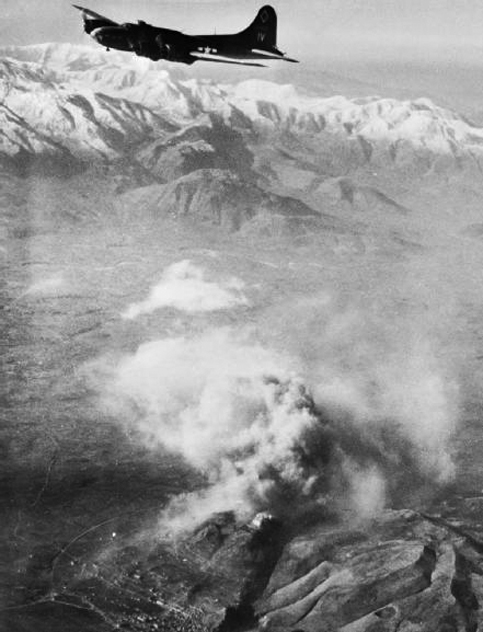 YouTube (Cassino Monastery Bombed - 1944) YouTube (Cassino Monastery Bombed - 1944)60+ B-24s attack the Poggibonsi marshalling yard, Campoleone and Porto d'Ascoli; heavy cloud cover causes numerous aborts; all the missions are unescorted. other B-26s bomb the railroad at Monte Molino and marshalling yard at Montepescali; A-20s attack motor transport, roads and road junction in the Albano Laziale area and NW of Valmontone; P-40s bomb concentrations near Cisterna di Roma and dumps in the Valmontone and Rocca di Papa areas; A-36s hit concentrations N of the Anzio beachhead, strafe trucks and barracks in the Frosinone-Rieti areas, bomb the Tiburtina and Trastevere marshalling yards in the Rome area and hit buildings N of Velletri. Off Anzio, destroyer escort 'Herbert C. Jones' (DE-137) is damaged by radio-controlled bomb and large infantry landing craft LCI(L)-2 is damaged by mine. Bomb holes freighter 'Elihu Yale'; the explosion start fires that spread to tank landing craft LCT-35 alongside, destroying that vessel as well. Firefighting efforts by fleet tug 'Hopi' (ATF-71) ultimately prove successful but 'Elihu Yale' is later written off as a total loss. Two of the 40-man Armed Guard perish in the attack, as do three of the 45-man merchant complement and seven of the 182 stevedores working cargo. Tank landing craft LCT-152 rescues survivors from 'Elihu Yale' and LCT-35. United StatesPhoto: The U.S. Navy attack transport USS Leon (APA-48) in New York harbor (USA) on 15 February 1944. She is painted in Camouflage Measure 32, Design 3D Pacific War Pacific WarBURMA-INDIA (Tenth Air Force): P-40s, P-51s, and A-36s hit targets in Burma, including rice mill and radio station at Waingmaw, targets of opportunity along the Hukawng-Walawbum road, motor pool and dumps in the Kamaing area, troops and supplies at Padi Ga and a canal bridge at Ye-u; P-40s also drop land mines on Nampaung. HQ 443d Troop Carrier Group is moved from the US to Sylhet, India without personnel and equipment. The 1st, 2d and 27th Troop Carrier Squadrons, already in the theater, will be assigned on 6 Mar. CHINA (Fourteenth Air Force): 4 B-25s on a sweep in N French Indochina score a direct hit on a steamer at Haiphong and nearby railroad station, damage bridges near Viet Tri and a patrol launch at Hanoi, and hit engine sheds at Thanh Hoa. PACIFIC OCEAN AREA (Seventh Air Force): B-24s from Tarawa and Makin pound Mille Atoll and Ponape Island; 10 P-40s from Makin Island bomb and strafe runways and a disabled vessel at Mille Atoll. SOUTH PACIFIC AREA (Thirteenth Air Force): 23 B-25s, with fighter cover, bomb the runway and dispersal area of Vunakanau Airfield; 20 B-24s hit Borpop Airfield causing heavy damage in the runway and revetment areas. In ground action, US and New Zealand troops land on Nissan Island in the Green Islands, 40 mi (64 km) NW of Buka on Buka Island; opposition is weak and organized resistance ends on 23 Feb. 424th Bombardment Squadron (Heavy), 307th Bombardment Group (Heavy), ceases operating from Munda, New Georgia Island with B-24s and returns to base on Guadalcanal Island. SOUTHWEST PACIFIC AREA (Fifth Air Force): On New Ireland Island, 70+ B-24s, A-20s, and B-25s bomb the Kavieng town, harbor, and shipping and Panapai Airfield. Lost are B-25C "Stubborn Hellion" 42-32314, B-25D "Gremlins Holiday" 41-30041, B-25C "Pissonit" 41-30370, B-25D 41-30531, B-25G 42-64873, A-20G 42-86728, and A-20G 42-86616. Several of the crews are rescued by PBY Catalina "Arkansas Traveller" 08139 piloted by Nathan G. Gordon, later he earns the Medal of Honor for this action. 17 other B-24s, prevented by weather from reaching Panapai, bomb Talasea. PACIFIC TF 31 (Rear Admiral Theodore S. Wilkinson) lands Third New Zealand Division (Major General H. E. Barraclough) on Green Island, east off New Ireland. TF 38 (Rear Admiral Walden C. Ainsworth) (two light cruisers and five destroyers) covers the operation from the south; TF 39 (Rear Admiral Aaron S. Merrill) (two light cruisers and five destroyers) from the north and east; Solomons-based aircraft also operate in support. During Japanese air attack on invasion shipping, tank landing ship LST-486 is damaged by near-miss of bomb off Green Island. Naval aircraft from Abemama, Gilbert Islands, bomb Wake Island. Submarine Aspro (SS-309) sinks Japanese submarine I-43, transporting sailors from the Sasebo Special Landing Force to Truk, 280 miles east-southeast of Guam, 10°23'N, 150°23'E. Submarine Gato (SS-212) sinks Japanese guardboat No.3 Taiyo Maru off Rabaul, New Britain, 04°00'N, 150°10'E. Submarine Snook (SS-283) sinks Japanese merchant cargo ship No.2 Hoshi Maru off south coast of Korea, 34°23'N, 128°23'E. Submarine Steelhead (SS-280) damages Japanese cargo ship Enju Maru 110 miles from Chichi Jima. Submarine Tinosa (SS-283) attacks Japanese convoy east of Mindanao, P.I., sinking army cargo ship Odatsuki Maru east of Dinagat Island, 09°30'N, 127°00'E (see 16 February 1944). British submarine HMS Tally Ho sinks German-manned Italian cargo submarine UIT-23, 04°53'N, 100°15'E. USAAF B-25s and A-20s damage auxiliary netlayer Matsu Maru at Rabaul. USAAF B-25s (14th Air Force) sink Vichy French patrol craft Ping Sang off Hongay, French Indochina, 21°00'N, 107°22'E. Mine laid by 14th Air Force B-24s on 10 February sinks Japanese merchant cargo ship Ryoka Maru off entrance to Yangtze River, 31°16'N, 121°46'E; a mine also sinks merchant cargo ship Hoshi Maru off south coast of Korea, 34°27'N, 128°45'E.
|
|
lordroel
Administrator
Posts: 68,061 
Likes: 49,462
|
Post by lordroel on Feb 16, 2023 3:54:12 GMT
Day 1620 of World War II, February 16th 1944Eastern FrontElements of the German 3rd Panzerkorp are stopped 12 miles from the perimeter of the Korsun Pocket. They have captured a bridge over the Gniloy Tikich River but, are exhausted and conclude that any further action would be fruitless. The 56,000 men of Group Stemmermann inside the pocket are ordered to prepare for a breakout attempt. Continuation WarFinish and Soviet authorities meet in Stockholm, Sweden to discuss terms for an armistice. Air War over EuropeThe British Air Minister says that bomber losses for 1943 were, 2,369 U.K. and 997 U.S. planes down. Another Halifax bomber based at Leconfield airfield, near Beverley, England was returning from ops and had made it back to Yorkshire despite all of his navigational aids being u/s. The visibility was poor and fuel was getting short so the pilot and crew baled out during which three were injured, one seriously. The Halifax crashed near the railway line between Sessay Wood and Coxwold, Yorkshire, some 50 miles NW of the airfield between 01.20 and 01.50. Italian CampaignFighting at Anzio intensifies as Kesselring throws a force of seven divisions into the attack hitting the US 45th and British 56th Divisions hard. German aircraft lend strong support to the attacks and hit allied shipping as well. The ammunition ship Elihu Yale is destroyed in one air attack. At Cassino, the New Zealanders continue to throw themselves against the German paratroops and make little headway. In Italy, US Fifteenth Air Force B-24s, unescorted, bomb marshalling yards at Pontassieve, Siena, Poggibonsi and Prato, a bridge at Cecina, and a railroad and highway near Rieti. Twelfth Air Force B-25s bomb the Orte marshalling yard and attack the Campoleone area; B-26s bomb San Stefano al Mare and hit the area near the Perugia railroad bridge, a bridge N of Orvieto, a factory near the Marsciano bridge and a bridge at Albinia Station; A-20s, with RAF and South African Air Force (SAAF) Baltimores and Spitfires, hit concentrations in the Anzio battle area; A-36s bomb the Rome/Tiburtina and Rome/Ostiense marshalling yards in the Rome area; P-40s attack Monte Cassino Abbey, pound tanks, trucks, and troop concentrations along the US Fifth Army front, and hit the towns of Fondi and Roccasecca; fighters over Anzio encounter increased air effort in conjunction with an all-out ground offensive against the Allied beachhead. Battle of the MediterraneanDestroyer Hilary P. Jones (DD-427) is damaged by near- miss of bomb off Anzio. United StatesPhoto: The U.S. Navy aircraft carrier USS Lexington (CV-16) off the Puget Sound Navy Yard, Washington (USA), on 16 February 1944. Lexington had been under repair for torpedo damage and addition of more quad 40mm mounts to upgrade her AA capability Pacific War Pacific WarGILBERT AND MARSHALL ISLANDS CAMPAIGN Operation Hailstone: US Navy carrier aircraft catch a fleet of Japanese Merchant vessels and warships by surprise in Truk Lagoon. 400 tons of bombs and torpedo rained down on the lightly defended base. After a day of attacks, forty ships and thousands of men went to the bottom. Photo: U.S. Navy Vought F4U-2 Corsairs of Night Fighting Squadron 101 (VF(N)-101), Detachment B lead other aircraft of Carrier Air Group 6 (CVG-6) as they prepare to launch from the aircraft carrier USS Intrepid (CV-11) for a raid against Truk in 16-17 February 1944
 Photo: Aboard the U.S. Navy aircraft carrier USS Enterprise (CV-6), PhoM 1/c Joe Day (foreground) and PhoM 1/c Len Globus (top) examine a Douglas SBD-5 Dauntless of Bombing Squadron 10 (VB-10), damaged during a photographic mission over Truk Atoll, 16-17 February 1944 Photo: Aboard the U.S. Navy aircraft carrier USS Enterprise (CV-6), PhoM 1/c Joe Day (foreground) and PhoM 1/c Len Globus (top) examine a Douglas SBD-5 Dauntless of Bombing Squadron 10 (VB-10), damaged during a photographic mission over Truk Atoll, 16-17 February 1944 Photo: View of the airfield on Moen Island, Truk Lagoon, from U.S. Navy Grumman TBF Avenger of Torpedo Squadron Six (VT-6) from USS Intrepid (CV-11) on 16 February 1944 Photo: View of the airfield on Moen Island, Truk Lagoon, from U.S. Navy Grumman TBF Avenger of Torpedo Squadron Six (VT-6) from USS Intrepid (CV-11) on 16 February 1944 Photo: View from a U.S. Navy Douglas SBD-5 Dauntless towards Dublon and Eten islands during the attacks on Truk lagoon, 16 February 1944 Photo: View from a U.S. Navy Douglas SBD-5 Dauntless towards Dublon and Eten islands during the attacks on Truk lagoon, 16 February 1944 Photo: View south from U.S. Navy Grumman TBF Avenger of Torpedo Squadron Six (VT-6) from USS Intrepid (CV-11) towards Dublon Island, Truk Lagoon, on 16 February 1944. Dublon Island is in the center, with Eten and Uman behind. Fefan Island is to the right Photo: View south from U.S. Navy Grumman TBF Avenger of Torpedo Squadron Six (VT-6) from USS Intrepid (CV-11) towards Dublon Island, Truk Lagoon, on 16 February 1944. Dublon Island is in the center, with Eten and Uman behind. Fefan Island is to the right Photo: U.S. Navy strike photograph showing a hit on a ship during the attacks on Truk lagoon, 16 February 1944 Photo: U.S. Navy strike photograph showing a hit on a ship during the attacks on Truk lagoon, 16 February 1944 Photo: Japanese ships in Truk Lagoon under attack, 16 February 1944. Eten Island is in the center. The photo was taken from a U.S. Navy Grumman TBF Avenger of Torpedo Squadron Six (VT-6) from USS Intrepid (CV-11) at about 0845 hrs Photo: Japanese ships in Truk Lagoon under attack, 16 February 1944. Eten Island is in the center. The photo was taken from a U.S. Navy Grumman TBF Avenger of Torpedo Squadron Six (VT-6) from USS Intrepid (CV-11) at about 0845 hrs Photo: Japanese ships in Truk Lagoon under attack, 16 February 1944. Eten Island is in the center. The photo was taken from a U.S. Navy Grumman TBF Avenger of Torpedo Squadron Six (VT-6) from USS Intrepid (CV-11) at about 0845 hrs Photo: Japanese ships in Truk Lagoon under attack, 16 February 1944. Eten Island is in the center. The photo was taken from a U.S. Navy Grumman TBF Avenger of Torpedo Squadron Six (VT-6) from USS Intrepid (CV-11) at about 0845 hrs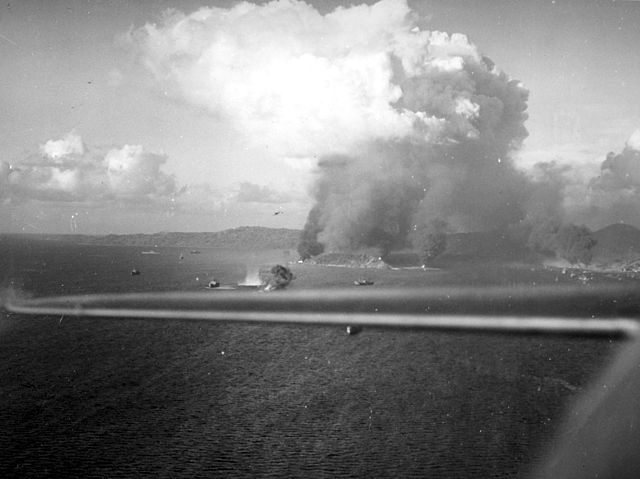 Photo: The Japanese light cruiser Katori underway in Truk Lagoon, as seen from U.S. Navy Grumman TBF Avenger of Torpedo Squadron Six (VT-6) from USS Intrepid (CV-11) on 16 February 1944. Katori was damaged by air attack and sunk the next day off Truk by the heavy cruisers USS New Orleans (CA-32), USS Minneapolis (CA-36) and the destroyers USS Radford (DD-446) and USS Burns (DD-588) Photo: The Japanese light cruiser Katori underway in Truk Lagoon, as seen from U.S. Navy Grumman TBF Avenger of Torpedo Squadron Six (VT-6) from USS Intrepid (CV-11) on 16 February 1944. Katori was damaged by air attack and sunk the next day off Truk by the heavy cruisers USS New Orleans (CA-32), USS Minneapolis (CA-36) and the destroyers USS Radford (DD-446) and USS Burns (DD-588)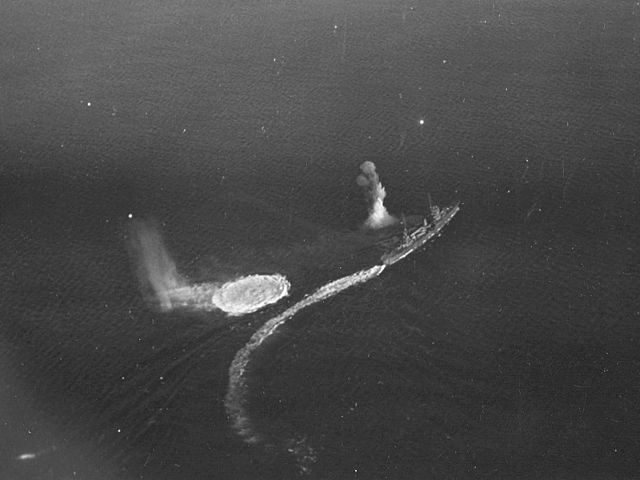 Photo: The U.S. Navy Grumman F6F-3 Hellcat from Fighting Squadron 9 (VF-9) flies over the beached Japanese destroyer Tachikaze, during Task Force 58's strikes on the Japanese naval base at Truk, Caroline Islands, 16-17 February 1944. VF-9 was assigned to Carrier Air Group 9 (CVG-9) aboard the aircraft carrier USS Essex (CV-9) Photo: The U.S. Navy Grumman F6F-3 Hellcat from Fighting Squadron 9 (VF-9) flies over the beached Japanese destroyer Tachikaze, during Task Force 58's strikes on the Japanese naval base at Truk, Caroline Islands, 16-17 February 1944. VF-9 was assigned to Carrier Air Group 9 (CVG-9) aboard the aircraft carrier USS Essex (CV-9) Photo: Aerial view of U.S. Navy strikes on Engebi island on 16 February 1944. The photo was taken by an aircraft from the aircraft carrier USS Saratoga (CV-3) Photo: Aerial view of U.S. Navy strikes on Engebi island on 16 February 1944. The photo was taken by an aircraft from the aircraft carrier USS Saratoga (CV-3)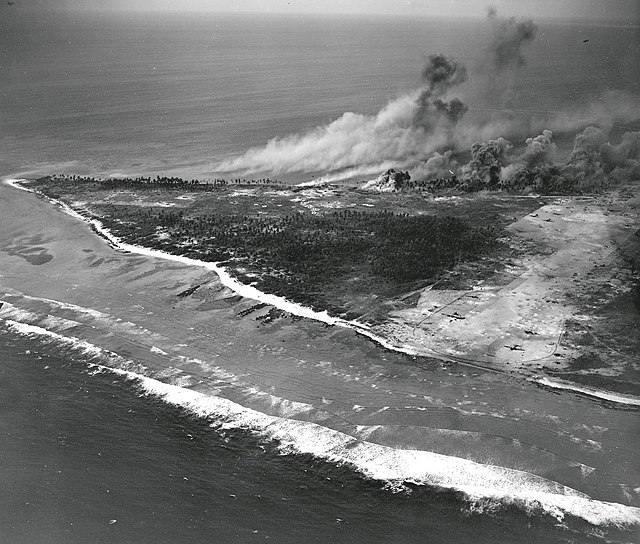 BURMA-INDIA (Tenth Air Force): In Burma, A-36s and P-51s hit supply dumps, troop concentrations and an encampment area near Myitkyina, Kamaing, Tonkin and Walawbum; B-25s and P-51s destroy 3 locomotives at Kyaingkwin. 118th Tactical Reconnaissance Squadron, AAF, India-Burma Sector (attached to Tenth Air Force), arrives at Gushkara, India from the US with P-51s. CHINA (Fourteenth Air Force): 2 B-25s knock out a railroad bridge at Yen Bay, French Indochina and damage 2 other bridges to the S near the coast. 74th Fighter Squadron, 23d Fighter Group, based at Kweilin with P-40s, sends a detachment to Liuchow. PACIFIC OCEAN AREA (Seventh Air Force): B-24s from Tarawa Atoll bomb Wotje Atoll and Taroa; P-40s from Makin fly 2 bombing-strafing strikes against Jaluit Atoll; A-24s bomb Mille Atoll. SOUTH PACIFIC AREA (Thirteenth Air Force): 12 B-24s, with 30+ P-38s and USN F4Us, pound the runway at Vunakanau Airfield. SOUTHWEST PACIFIC AREA (Fifth Air Force): 40+ B-25s attack a convoy off New Hanover Island. 30+ B-24's bomb Panapai Airfield and Kavieng on New Ireland Island, and some hit Cape Balangori and Talasea, New Britain Island. 19 B-24s and B-25s bomb Halong in the Celebes Islands. P-40s hit shipping and barges in the Wewak, New Guinea area. Transfers in New Guinea: HQ 345th Bombardment Group (Medium) from Dobodura to Nadzab; 25th Liaison Squadron, 5212th Photographic Wing (Provisional), from Lae to Nadzab with L-5s. Crashed in an emergency landing attempt is L-5A 42-98066. PACIFIC Destroyer Phelps (DD-360) and minesweeper Sage (AM-111) sink Japanese submarine RO-40, 45 miles northwest of Kwajalein, Marshalls, 09°50'N, 166°35'E. Submarine Skate (SS-305) sinks Japanese light cruiser Agano 170 miles north of Dublon Island, Truk, 10°10'N, 151°40'E. Submarine Tinosa (SS-283) continues pursuit of convoy engaged the previous day, and sinks Japanese army cargo ship Chojo Maru off Sarangani Island, 09°15'N, 127°05'E. USAAF B-25s (38th and 345th Bomb Groups) carry out succession of attacks on Japanese convoy off New Hanover and Kavieng, sinking submarine chaser Ch 39, auxiliary submarine chaser Cha 16, and transport Sanko Maru, 02°24'S, 150°06'E. Japanese transport Sanko Maru is sunk by aircraft off New Hanover Island, 02°24'S, 150°06'E.
|
|
lordroel
Administrator
Posts: 68,061 
Likes: 49,462
|
Post by lordroel on Feb 17, 2023 6:57:01 GMT
Day 1621 of World War II, February 17th 1944Eastern FrontThe End At Korsun: Led by the remnants of the elite 5th SS Panzer Division, Group Stemmermann launches their attempt to break out of the Korsun Pocket. In a blinding snowstorm they manage to find a seam in the Soviet defenses. At dawn, the weather clears and the Soviet cavalry and aircraft pounce on the columns of fleeing Germans. Having abandoned their heavy equipment, the breakout turns into a rout as desperate men flee from the carnage. General Stemmermann was killed in action along with many of his men. The Russian attacks force many of the refugees away from the bridge over the Gniloy Tikich River. When the fugitives reached the bank, many chose to swim the near freezing river rather than be captured. In the end, some did escape. Estimates vary greatly. Around 35,000 men escaped. They had little other than their personal weapons and often not even that. In the final analysis, the escapees were badly shaken and any semblance of organization had evaporated. The Germans had lost 10 divisions for some time to come. Map: The German breakout Italian Campaign Italian CampaignThe Germans continue their counterattack against the Anzio beachhead hitting the US 45th Division particularly hard. Although both sides suffered heavy losses, the Germans came very near a decisive breakthrough to the beach. US artillery units firing over open sights from the beach and ships off shore managed to stop and turn back the German drive. At Casino, the 4th Indian Division managed to capture a part of the Cassino defenses (Point 593) but it was lost to German counterattacks. Photo: Jeeps assembled ready for transporting supplies to the forward positions, 17 February 1944 The 455th and 456th Bombardment Groups (Heavy) become operational giving the Fifteenth Air Force 12 B-24 groups. In Italy, unescorted B-17s and B-24s attack Campoleone and Grottaferrata, motor transport parks in the Campoleone junction and Rocca di Papa areas, a troop concentration near Frascati, stores depots in the Grottaferrata area, and other targets in advance of the US Fifth Army's Anzio battle line which is under heavy counterattack by German forces. US Twelfth Air Force B-25s bomb the Campoleone and Lanuvio area, B-25s hit dumps SW of Rome and N of Anzio, and also hit guns nearby; A-20s blast a dump and troop concentrations in the Anzio area; P-47s bomb dumps near Valmontone; A-36s hit Carroceto, concentrations SE of Rome, and a railroad underpass and a factory N of Anzio; P-40s blast enemy transport, guns, and assembly areas N of Cisterna di Latina, trucks N of Anzio and N of the beachhead battleline, railroad stations at Campoleone and Carroceto, and bivouac areas, dumps, a factory, and bridge in the battle area; this entire air effort (the heaviest to date in support of troops) is aimed at helping prevent a breakthrough at the beachhead, where the Germans are committed to a full-strength counter-offensive; A-36s bomb Monte Cassino Abbey in the only air action on the US Fifth Army main front. Off Anzio, destroyers Madison (DD-425) and Eberle (DD- 430) make sound contact 25 miles southwest of the port; five-hour search yields no result. Tank landing craft LCT-277 is damaged in air raid. During German air raid on the port of Naples, Italy, U.S. freighter James Guthrie is damaged by bomb; there are no casualties among the ship's company. German submarine U-371 attacks Naples-bound convoy SNF 17 about 30 miles north-northeast of Bougie, Algeria, and torpedoes U.S. freighter Maiden Creek, 37°08'N, 05°27'E. Initially, the ship is abandoned, but is reboarded and prepared for towing. U-371 again torpedoes Maiden Creek, the resulting explosion killing six merchant seamen and two of the 29-man Armed Guard. Destroyer MacKenzie (DD-614) joins three British escort vessels for submarine hunt off Philippeville, with no results. United KingdomAdvanced HQ, Ninth Air Force, is opened at Hillingdon House, Uxbridge. It is later joined in the area by advanced units of the IX Fighter Command and by troop carrier units, all of which form a nucleus of advanced echelons so as to centralize tactical operations in anticipation of combat on the Continent. Battle of the AtlanticAircraft (VC 6) from escort carrier Block Island (CVE- 21), along with destroyer Corry (DD-463), and destroyer escort Bronstein (DE-189) sink German submarine U-801 west of the Cape Verdes, 16°42'N, 30°26'W. Battle of the Indian OceanLast survivors of U.S. tanker H.D.Collier, torpedoed and shelled by Japanese submarine I-26 on 13 March 1944, are rescued by steamship Karagola. United StatesPhoto: The U.S. Navy transport USS General R. L. Howze (AP-134) at anchor off San Francisco, California (USA), on 17 February 1944 Photo: The U.S. Navy destroyer escort USS Thomason (DE-203) off Charleston, South Carolina (USA), on 17 February 1944. She is painted in Camouflage Measure 32, Design 16D Photo: The U.S. Navy destroyer escort USS Thomason (DE-203) off Charleston, South Carolina (USA), on 17 February 1944. She is painted in Camouflage Measure 32, Design 16D Photo: The U.S. Navy light cruiser USS Miami (CL-89) steaming in heavy seas during her shakedown cruise on 17 February 1944 Photo: The U.S. Navy light cruiser USS Miami (CL-89) steaming in heavy seas during her shakedown cruise on 17 February 1944 Pacific War Pacific WarGILBERT AND MARSHALL ISLANDS CAMPAIGN TF 58 (Vice Admiral Raymond A. Spruance), which includes nine carriers and six battleships, strikes Japanese installations and shipping at Truk, in Operation Hailstone inflicting massive damage; enemy air attacks in response succeed in only damaging carrier Intrepid (CV-11) with an aerial torpedo, 07°23'N, 153°32'E. Photo: A U.S. Navy Douglas SBD-5 Dauntless of bombing squadron VB-16 off the aircraft carrier USS Lexington (CV-16) pictured over Dublon and Eten Island en route to strike Japanese installations at Truk, 17-18 February 1944. VB-16 operated from Lexington during the period September 1943-June 1944, and was for a time one of only two Dauntless squadrons assigned to Pacific fleet carriers. The squadron also participated in the famous attack against the Japanese Fleet during the Battle of the Philippine Sea in June 1944 Photo: U.S. Navy Douglas SBD-5 Dauntless dive bombers of Bombing Squadron 16 (VB-16) off USS Lexington (CV-16) fly low over Japanese installations on Param Island, Truk Atoll, 17-18 February 1944. Note the smoke rising from the buildings Photo: U.S. Navy Douglas SBD-5 Dauntless dive bombers of Bombing Squadron 16 (VB-16) off USS Lexington (CV-16) fly low over Japanese installations on Param Island, Truk Atoll, 17-18 February 1944. Note the smoke rising from the buildingsSB2Cs and TBFs from carrier Bunker Hill (CV-17) and TBFs from small carrier Cowpens (CVL-25) sink Japanese light cruiser Naka 35 miles west of Truk, 07°15'N, 151°15'E, while battleships New Jersey (BB-62) and Iowa (BB-61), heavy cruisers Minneapolis (CA-36) and New Orleans (CA-32) and destroyers Radford (DD-446) and Burns (DD-588) sink training cruiser Katori northwest of Truk, 07°45'N, 151°20'E, after she had been damaged by planes from carriers Yorktown (CV-10), Intrepid (CV- 11) and Bunker Hill (CV-17) and small carrier Cowpens. TG 50.3 gunfire sinks destroyer Maikaze 40 miles northwest of Truk, 07°45'N, 151°20'E. Destroyer Burns (DD-588), detached from TG 50.9, sinks Japanese submarine chaser Ch 24 west of Truk, 07°24'N, 150°30'E. 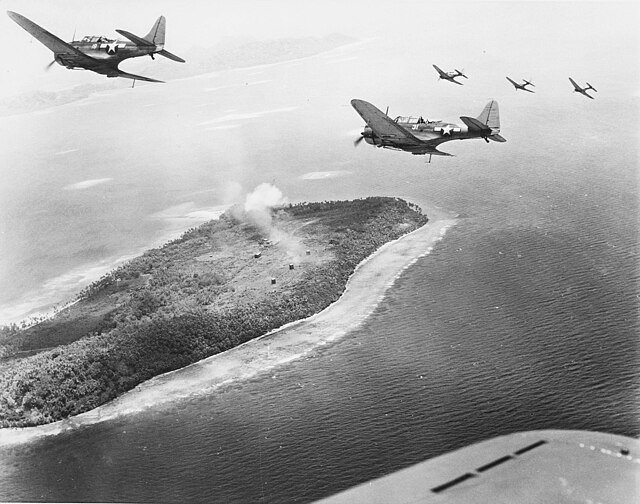 Photo: A U.S. Navy Douglas SBD-5 Dauntless of Bombing Squadron 5 (VB-5) lands on the aircraft carrier USS Yorktown (CV-10) after striking the Japanese base at Truk, 17-18 February 1944. The Yorktown senior Landing Signal Officer, Lt. JG Red Voltz, is visible on the right. Two planes in the landing circle can be seen in the background Photo: A U.S. Navy Douglas SBD-5 Dauntless of Bombing Squadron 5 (VB-5) lands on the aircraft carrier USS Yorktown (CV-10) after striking the Japanese base at Truk, 17-18 February 1944. The Yorktown senior Landing Signal Officer, Lt. JG Red Voltz, is visible on the right. Two planes in the landing circle can be seen in the background Photo: Japanese shipping under air attack in Truk Lagoon, as seen from a USS Intrepid (CV-11) aircraft on the first day of raids, 17 February 1944. Dublon Island is at left, with Moen Island in the background. Four of these ships appear to have been hit by this time Photo: Japanese shipping under air attack in Truk Lagoon, as seen from a USS Intrepid (CV-11) aircraft on the first day of raids, 17 February 1944. Dublon Island is at left, with Moen Island in the background. Four of these ships appear to have been hit by this timeTF 58 planes sink Japanese destroyer Oite (carrying survivors of light cruiser Agano sunk the day before), 07°40'N, 151°45'E; destroyer Tachikaze, 07°40'N, 151°55'E; armed merchant cruiser Akagi Maru, 07°54'N, 151°25'E; auxiliary submarine depot ship Heian Maru; aircraft transport Fujikawa Maru; transports Rio de Janeiro Maru, Kiyozumi Maru, Aikoku Maru, Gosei Maru, Hanakawa Maru, Hokuyo Maru, Amagisan Maru, and Kensho Maru; Matsutani Maru, 07°23'N, 151°05'E; Momokawa Maru, 07°20'N, 151°53'E; Reiyo Maru, 07°25'N, 151°45'E; San Francisco Maru, 07°22'N, 151°54'E; Seiko Maru, 07°22'N, 151°45'E; Taiho Maru, 07°22'N, 151°34'E; Zukai Maru,07°46'N, 150°27'E; No.6 Unkai Maru; Yamagiri Maru, 07°23'N, 151°51'E; fleet tankers Fujisan Maru, Hoyo Maru (damaged on 4 November 1943 by submarine Scorpion), Shinkoku Maru, and No.3 Tonan Maru; water carrier Nippo Maru, 07°20'N, 151°40'E; auxiliary vessel Yamakisan Maru, 07°25'N, 151°45'E; army cargo ships Nagano Maru and Yubai Maru; merchant cargo ship Taikichi Maru; and motor torpedo boat Gyoraitei No.10, 07°31'N, 151°59'E. 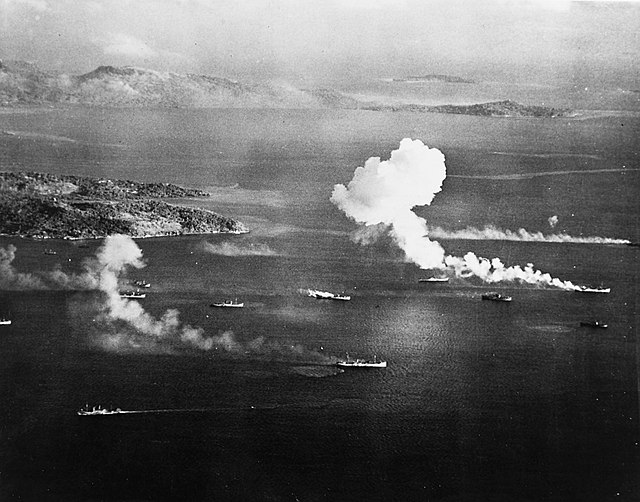 Photo: The Japanese light cruiser Katori burning off Truk Lagoon, as seen from U.S. Navy Grumman TBF Avenger of Torpedo Squadron Six (VT-6) from USS Intrepid (CV-11) on 17 February 1944. The destroyer Maikaze is in the left distance. Katori was damaged by air attack and sunk with Maikaze off Truk by the heavy cruisers USS New Orleans (CA-32), USS Minneapolis (CA-36) and the destroyers USS Radford (DD-446) and USS Burns (DD-588) Photo: The Japanese light cruiser Katori burning off Truk Lagoon, as seen from U.S. Navy Grumman TBF Avenger of Torpedo Squadron Six (VT-6) from USS Intrepid (CV-11) on 17 February 1944. The destroyer Maikaze is in the left distance. Katori was damaged by air attack and sunk with Maikaze off Truk by the heavy cruisers USS New Orleans (CA-32), USS Minneapolis (CA-36) and the destroyers USS Radford (DD-446) and USS Burns (DD-588)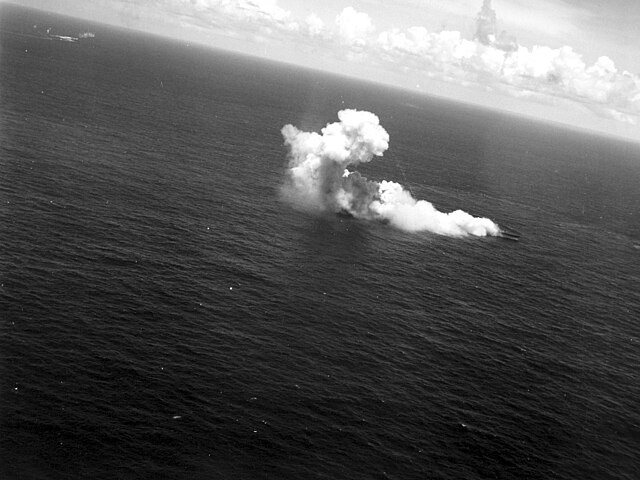 TF 58 aircraft damage Japanese destroyers Shigure and Matsukaze, submarines I 10 and RO 37, target ship Hakachi, repair ship Akashi, ammunition ship Soya, seaplane tender Akitsushima, and auxiliary submarine chaser Cha 20. BURMA-INDIA (Tenth Air Force): In Burma, 38 A-36s and P-51s on armed reconnaissance hit troops and supplies from Lonkin to Kamaing; 6 P-51s hit supply areas along roads around Lonton and Manywet; 2 others hit a road junction near Maingkwan; 2 B-25s and 6 P-51s strike a road bridge, railroad station, and rail cars in the Pyingaing area; 2 B-25s and 6 P-51s attack but fail to damage a bridge near Ye-u. CHINA (Fourteenth Air Force): In French Indochina, 4 B-25s on a sweep of the Gulf of Tonkin score 2 direct hits on a freighter at Vinh, damage a bridge approach and locomotive at Yen Xuon Station, and destroy a locomotive at Yen Ly Station. PACIFIC OCEAN AREA (Seventh Air Force): B-24s from Tarawa Atoll and Abemama Island hit Ponape and Kusaie Islands, and Jaluit Atoll. P-40s strafe floatplanes off Emidj Island. SOUTH PACIFIC AREA (Thirteenth Air Force): 20 P-40s join 40+ USN fighters in covering an attack by 70 USN dive bombers on shipping in Keravia Bay, New Britain Island; 8 Japanese aircraft are claimed shot down; 2 USN fighters are lost. In the N Solomons Allied fighters hit Queen Carola Harbor, Kessa Plantation and a bridge N of Kahili. SOUTHWEST PACIFIC AREA (Fifth Air Force): 40 B-24s bomb Panapai Airfield, New Ireland Island and Talasea, New Britain Island. 16 B-25s claim 2 surface vessels and a submarine sunk off New Hanover Island. 16 P-47's strafe targets of opportunity in the Alexishafen, New Guinea area. HQ 6th Photographic Reconnaissance Group moves from Port Moresby to Nadzab, New Guinea. ALASKA Photo: The U.S. Navy destroyer escort USS Edward C. Daly (DE-17) operating in Alaskan waters, life lines and netting and other exposed surfaces white with frozen spray, as seen from a Fleet Air Wing 4 aircraft, 17 February 1944 PACIFIC Destroyer Nicholas (DD-449) sinks Japanese submarine I-11 northwest of the Marshalls, 10°34'N, 173°31'E. Submarine Cero (SS-225) sinks Japanese transport Jozan Maru between Truk and New Ireland, 00°53'N, 146°26'E. Submarine Sargo (SS-188), in attack on Japanese convoy about 150 miles northeast of Palau, sinks ammunition ship Nichiro Maru and damages oiler Sata, 08°50'N, 135°40'E. Submarine Tang (SS-306) attacks Japanese convoy, sinking army cargo ship Gyoten Maru and merchant tanker Kuniei Maru about 130 miles west-northwest of Truk, 08°00'N, 149°17'E, and survives depth-charging by escorts (escort vessel Amakusa, submarine chaser Ch 31, auxiliary submarine chaser Cha 24 and auxiliary minesweeper Hagoromo Maru are screening the merchantmen). Navy SBDs and TBFs bomb Japanese shipping in Keravia Bay, near Rabaul, sinking minesweeper W.26 (which had been damaged previously, 2 November 1943, and had been beached at that time to prevent her loss), guardboat No.2 Fuku Maru, and army cargo ship Iwate Maru. USAAF B-25s attack Japanese ships going to the aid of convoy attacked north of New Hanover the day before (see 16 February), damaging Kashi Maru and forcing her to be run aground to prevent sinking. USAAF P-40s attack Japanese shipping at Jaluit atoll, damaging cargo ship Chosen Maru. Japanese merchant tanker Zuih_ Maru is damaged by mine downstream from Woosung, China.
|
|
lordroel
Administrator
Posts: 68,061 
Likes: 49,462
|
Post by lordroel on Feb 18, 2023 15:03:22 GMT
Day 1622 of World War II, February 18th 1944YouTube (The Destruction of Monte Cassino)Eastern FrontAttacks in the north of the eastern front continue to make progress as the Soviet 2nd Baltic Front captures Starayya-Russa and the Volkhov Front takes Shimsk. In the south, 1st and 2nd Ukrainian Fronts begin regrouping for fresh offensives as the Germans pull away from their exposed positions created from the break-in attempt. Soviet forces take control of Nikopol, with its manganese mines. Air War over Europe HQ Eighth Air Force issues orders to establish a photographic reconnaissance wing [8th Reconnaissance Wing (Provisional)] in Cheddington. The purpose is to make the Eighth independent in aerial reconnaissance and to consolidate the efforts of units presently engaged in this and related activities. Colonel Elliott Roosevelt, the President's son and currently Director of Reconnaissance for the Ninth Air Force, is named Commanding Officer. Unternehmen Steinbock: The Germans conduct their heaviest night raid on London since 1941 as the Luftwaffe intensifies the ‘Little Blitz’. The bombers managed to drop 175 tons within London. Operation Jericho: Mosquitoes of RAF Nos. 21, 464 and 487 Sqdrns led by GC P. C. Pickard attacked Amiens prison in a bid to release French Resistance workers held there by the Germans. The raid was successful, releasing 258 of the 700 prisoners held in the prison - although a further 102 were killed by the bombing. Two Mosquitoes were shot down, including the Mossie of GC Pickard who was killed. The 2 Mosquitoes were confirmed as victories for Lt. Waldemar Radener and Fw. Wilhelm Mayer, both from 7./JG 26. Photo: picture taken from the accompanying PRU Mosquito (the fuselage & tailwheel of which appears in the top-right of the picture) and also showing one of the attacking Mosquitoes (with bomb-doors open) at the extreme top-left of the picture. The Prison itself is the large, dark building, at the centre-left. IMW description (object 205023419) reads "Operation JERICHO: the daylight raid by 18 De Havilland Mosquito FB Mark VIs of No. 140 Airfield, No. 2 Group, led by Group Captain P C Pickard, to free resistance members awaiting execution in Amiens Jail, France. Here, Mosquitos of No. 487 Squadron RNZAF clear the target at low level as the first 500-lb bombs to be dropped detonate near the south wall of the prison" Photo: Operation Jericho - Amiens Jail During Raid 2 Photo: Operation Jericho - Amiens Jail During Raid 2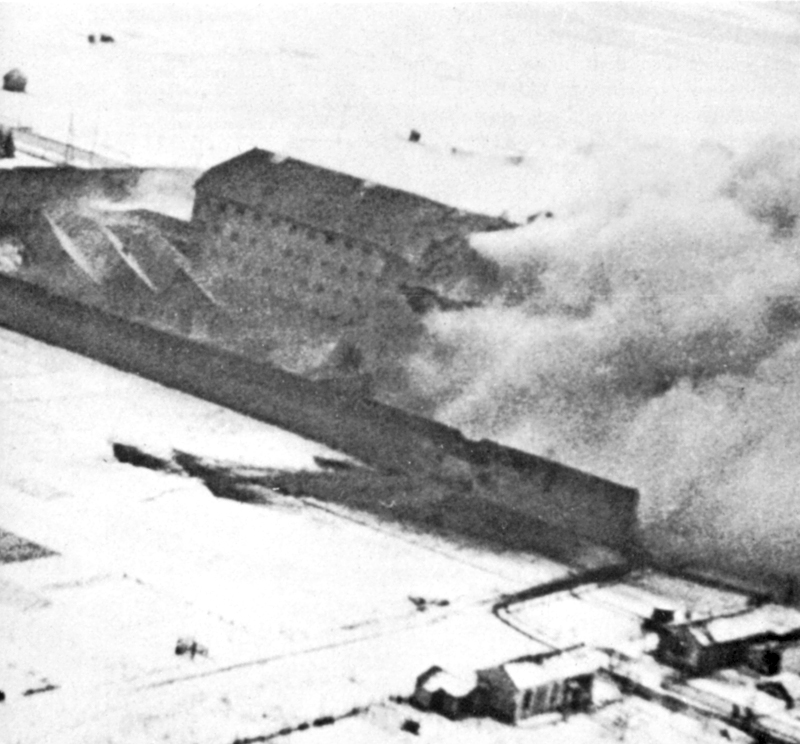 Italian Campaign Italian CampaignAt Anzio, the German attacks appear to be weakening but massed artillery and off-shore support are still needed to stabilize the situation in the beachhead. The last German reserves, the 26th Panzer and 29th Panzer Grenadier Divisions, are committed to the attack at Anzio. Once again, they make some gains but are stopped by a wall of artillery and naval gunfire. Meanwhile, attacks at Casino are called off to refit, rest and reform. To the south, Indian and New Zealand forces of the US 5th Army attempt to attack the hill masses north of Monte Cassino but are bloodily repulsed. Map: Second Battle of Monte Cassino: 15 - 18 February 1944. Plan of attack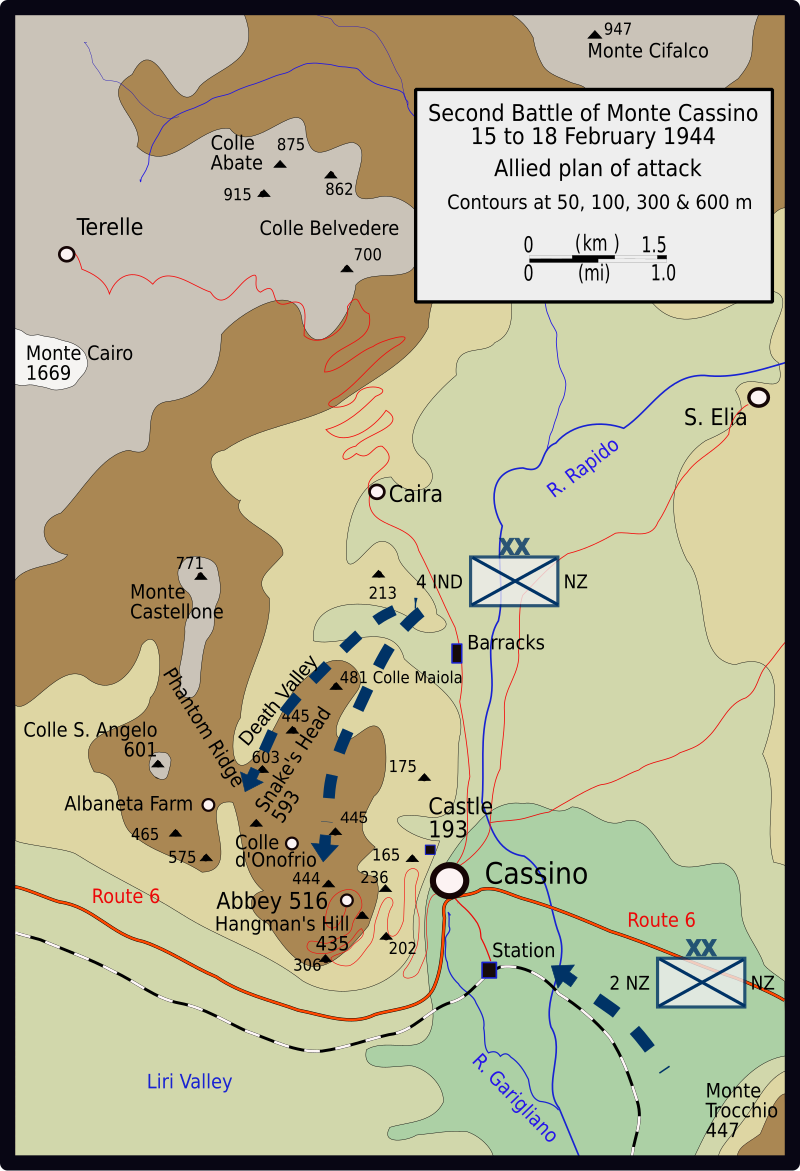 Heavy German air attacks, as well as artillery fire, continue on the beachhead at Anzio on an almost daily basis; harbor tug YT-198 is sunk by mine off Anzio. Elsewhere in the Mediterranean theater, tank landing craft LCT-205 capsizes in Gulf of Tunis, while being towed; tank landing craft LCT-340 is stranded by heavy weather at Pantelleria, Italy. Heavy weather also damages large infantry landing craft LCI(L)-211, resulting in her being towed to Palermo, Italy; and minesweeper 'Pilot' (AM-104) is accidentally rammed by U.S. merchant ship 'Samuel Ashe' and damaged off Naples, Italy. In Italy, A-20s hit a troop concentration near Piedimonte; XII Air Support Command P-40s and A-36s fly 17 missions in support of US Fifth Army troops resisting the German counteroffensive which reaches its deepest penetration into the Anzio beachhead on this day; objectives include tanks, vehicles, gun positions, troop concentrations, and a railroad underpass along the Anzio-Albano Laziale axis; fighters over Anzio successfully intercept air strikes on the beachhead; New Zealand troops capture Cassino Station. The British cruiser HMS 'Penelope' is torpedoed by 'U-410' off the coast of Italy between Naples and Anzio. She would be the last cruiser the British would loose in the war. United StatesPhoto: The U.S. Navy destroyer USS Longshaw (DD-559) underway at 1400hrs on 18 February 1944. She is painted in Camouflage Measure 32, Design 21D. The photo was taken from a blimp so squadron ZP-32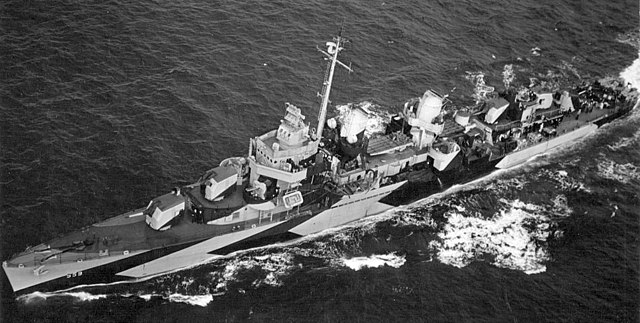 Photo: The U.S. Navy small saplane tender USS Gardiners Bay (AVP-39) off the Lake Washington Shipyards, Houghton, Washington (USA), on 18 February 1945. She is painted in Camouflage Measure 33, Design 1F Photo: The U.S. Navy small saplane tender USS Gardiners Bay (AVP-39) off the Lake Washington Shipyards, Houghton, Washington (USA), on 18 February 1945. She is painted in Camouflage Measure 33, Design 1F Photo: The U.S. Navy small saplane tender USS Gardiners Bay (AVP-39) off the Lake Washington Shipyards, Houghton, Washington (USA), on 18 February 1945. She is painted in Camouflage Measure 33, Design 1F Photo: The U.S. Navy small saplane tender USS Gardiners Bay (AVP-39) off the Lake Washington Shipyards, Houghton, Washington (USA), on 18 February 1945. She is painted in Camouflage Measure 33, Design 1F Pacific War Pacific WarGILBERT AND MARSHALL ISLANDS CAMPAIGN Operation Hailstone: for the second day, TF 58 (Vice Admiral Raymond A. Spruance) repeats strike on Japanese installations and vessels at Truk; TF 58 planes sink destroyer Fumizuki, 07°24'N, 151°44'E; submarine chaser Ch 29, 07°25'N, 151°45'E; and motor torpedo boat Gyoraitei No.10, 07°31'N, 151°59'E. YouTube (Yanks Smash Truk 1944 Operation Hailstone)Photo: A U.S. Navy Vought OS2U-3 Kingfisher is recovered by the heavy cruiser USS Baltimore (CA-68) after she had rescued Lieutenant (JG) George M. Blair from Truk Lagoon, 18 February 1944. The plane's pilot was Lieutenant (JG) Denver F. Baxter. His radioman, ARMC Reuben F. Hickman, is on the wing, preparing to attach the plane so it can be hoisted on board. Blair's Grumman F6F Hellcat of Fighting Squadron 9 (VF-9), from the aircraft carrier USS Essex (CV-9), had been shot down during the dawn fighter sweep over Truk Photo: A Japanese destroyer under attack near Truk Lagoon, as seen from U.S. Navy Grumman TBF Avenger of Torpedo Squadron Six (VT-6) from USS Intrepid (CV-11) on 18 February 1944. This could be the destroyer Oite. On 16 February, Oite was escorting the damaged cruiser Agano to Japan from Truk when Agano was torpedoed and sunk by the U.S. Navy submarine USS Skate (SS-305). Oite rescued 523 of Agano´s crew and turned back towards Truk. However, just as Oite was entering Truk Lagoon on 18 February, the Japanese base was struck by United States Navy aircraft in Operation Hailstone. Oite was torpedoed, broke in half and sank almost immediately with loss of 172 of 192 crewmen and all 523 survivors of Agano Photo: A Japanese destroyer under attack near Truk Lagoon, as seen from U.S. Navy Grumman TBF Avenger of Torpedo Squadron Six (VT-6) from USS Intrepid (CV-11) on 18 February 1944. This could be the destroyer Oite. On 16 February, Oite was escorting the damaged cruiser Agano to Japan from Truk when Agano was torpedoed and sunk by the U.S. Navy submarine USS Skate (SS-305). Oite rescued 523 of Agano´s crew and turned back towards Truk. However, just as Oite was entering Truk Lagoon on 18 February, the Japanese base was struck by United States Navy aircraft in Operation Hailstone. Oite was torpedoed, broke in half and sank almost immediately with loss of 172 of 192 crewmen and all 523 survivors of Agano The 22d Marine Regiment lands on Engebi Island at the northern tip of the atoll at 0845 hours. This is part of Operation CATCHPOLE. There are over 1,200 Japanese Okinawans and Koreans on the island. Organized resistance ceases at 0800 hours local tomorrow; only 16 of the occupiers are captured. American casualties are 85 KIA and MIA and 521 WIA. Photo: Aerial of U.S. invasion of Engebi Island in Eniwetok atoll on 18 February 1944. The flares signal fleet units to lift the bombardment so that landing craft may approach the beaches BURMA-INDIA (Tenth Air Force): In Burma, 40+ B-25s, A-36s and P-51s attack the town of Ye-u and nearby bridge, bivouacs N of Laban, bridges in the Pyingaing area and along the Mu River, supply and troop concentrations at Waingmaw radio station and a supply area near Kamaing and gun emplacements SE of Taihpa Ga; the strikes are generally successful. 58th Fighter Squadron, 33d Fighter Group, arrives at Karachi, India from Italy; they will be equipped with P-47Ds. CHINA (Fourteenth Air Force): In French Indochina, 4 B-25s on a sweep of the Gulf of Tonkin damage 2 large boats N of Bakli Bay on Hainan Island, destroy an ammunition dump at Phu Ly and knock out a nearby railroad bridge. PACIFIC OCEAN AREA (Seventh Air Force): P-40s from Makin bomb and strafe Jaluit and Mille Atolls. US forces land on Engebi Island in Eniwetok Atoll. SOUTH PACIFIC AREA (Thirteenth Air Force): 34 B-25s and 18 B-24s, both forces with fighter escorts, pound Vunakanau Airfield; 2 B-25s and 4 P-38s hit Tobera. SOLOMON ISLANDS CAMPAIGN Destroyer Squadron 23 or Task Group 39.4 under Captain Arleigh A. Burke bombards Japanese positions at Kavieng on New Ireland Island; on New Britain Island, Destroyer Squadron 12 under Captain Rodger W. Simpson shells Rabaul, Japanese installations on the Crater Peninsula, and bivouac and supply areas at Vunapope and Cape Gazelle. Photo: Ships of the U.S. Navy Destroyer Squadron 12 (DesRon 12) returning from a bombardment of Rabaul and salute the dead with S-turns in Ironbottom Sound. This had become a custom whenever DesRon12 ships passed Savo Island after a successful raid against the Japanese. Commanded by Captain Rodger W. Simpson, the squadron raided Rabaul on 17-18 and 23-25 February 1944. The ships are:
USS Farenholt (DD-491), flagship, USS Buchanan (DD-484), USS Woodworth (DD-460), USS Lardner (DD-487) and USS Lansdowne (DD-486) SOUTHWEST PACIFIC AREA (Fifth Air Force): B-25s and RAAF Beaufighters hit Koepang, Timor Island. P-39s strafe targets of opportunity at Madang and Cape Raoult, New Britain Island. 499th Bombardment Squadron (Medium), 345th Bombardment Group (Medium), moves from Dobodura to Nadzab, New Guinea with B-25s. HAWAII Photo: The U.S. Navy destroyer USS Thatcher (DD-514) at Pearl Harbor on 18 February 1944. The ship is painted in Camouflage Measure 31, Design 2C. The photo was taken from the forecastle of the battleship USS Washington (BB-56) which had been damaged in a collision with USS Indiana (BB-58) on 1 February 1944 PACIFIC British submarine HMS Trespasser sinks Japanese gunboat Eifuku Maru off Burma, 07°55'N, 93°03'E. USAAf B-25s (14th Air Force) sink Japanese transport Shinsoku Maru south of Takhow Island, Wenchow, China, 28°23'N, 121°51'E. U.S. aircraft sink Japanese auxiliary submarine chaser Cha 17 off Kavieng, 02°30'S, 150°30'E. Japanese cargo ship Gokenzan Maru is stranded and sunk off northwestern Hokkaido, 44°01'N, 141°38'E.
|
|
lordroel
Administrator
Posts: 68,061 
Likes: 49,462
|
Post by lordroel on Feb 19, 2023 7:39:45 GMT
Day 1623 of World War II, February 19th 1944Eastern Front German forces have reduced General Bor-Komorowski's hold on Warsaw to three isolated pockets, and the Polish Home Army and the attempt by communist partisans' (the People's Guard) to regain control of Warsaw must now depend on substantial aid from the Russians, poised just on the other side of the river Vistula. But Stalin has refused to aid the valiant Poles. The Russians have three operational airfields a few minutes' flight from Warsaw, while the RAF and South African bombers attempting to drop supplies to the Poles must fly from Foggia across Europe under constant Luftwaffe attacks. Of ten bombers which set out for Warsaw from Italy three days ago, six failed to return. What makes the loss of these aircraft and crews especially sad is that Stalin will not allow the RAF supply planes to land on Russian-controlled airfields. The Poles seem doomed in the face of such intransigence. Air War over Europe 823 RAF aircraft - 561 Lancasters, 255 Halifaxes, 7 Mosquitos were sent to Leipzig. 78 aircraft - 44 Lancasters and 34 Halifaxes - were lost, 9.5 per cent of the force. The Halifax loss rate was 13.3 per cent of those dispatched and 14.9 per cent of those Halifaxes which reached the enemy coast after 'early returns' had turned back. The Halifax IIs and Vs were permanently withdrawn from operations to Germany after this raid. This was an unhappy raid for Bomber Command. The German controllers only sent part of their force of fighters to the Kiel minelaying diversion. When the main bomber force crossed the Dutch coast, they were met by a further part of the German fighter force and those German fighters which had been sent north to Kiel hurriedly returned. The bomber stream was thus under attack all the way to the target. There were further difficulties at the target because winds were not as forecast and many aircraft reached the Leipzig area too early and had to orbit and await the Pathfinders. 4 aircraft were lost by collision and approximately 20 were shot down by flak. Hptm. Martin Becker of 2./NJG 6 claimed 4 Lancasters. Leipzig was cloud-covered and the Pathfinders had to use skymarking. The raid appeared to be concentrated in its early stages but scattered later. 45 RAF Stirlings and 4 Pathfinder Halifaxes minelaying in Kiel Bay, 16 Oboe Mosquitos bombing night-fighter airfields in Holland, 15 Mosquitos on a diversion raid to Berlin, 12 Serrate patrols. 1 Mosquito lost from the Berlin raid. 3 Mosquitos attacked Aachen and 3 more bombed flying-bomb sites in France without loss. Total effort for the night: 921 sorties, 79 aircraft (8.6 per cent) lost. This was the heaviest Bomber Command loss of the war so far, easily exceeding the 58 aircraft lost on 21/22 January 1943 when Magdeburg was the main target. Italian CampaignAfter three days of desperate fighting the Allied divisions trapped on the Anzio beach-head halted a major German offensive. The attack was launched on 16 February, with General von Mackensen's XIV Armee supported by the Luftwaffe. A sustained artillery barrage opened up a gap in the sector held by the US 45th Division, and for a time, it appeared as though the Allied would be split in two. Panzers poured through the gap, but themselves came under attack as the Allies concentrated their own fire more effectively. Still, though, the Germans pushed the Allies back towards the beaches. But determined fighting by the British 1st and US 45th Divisions, backed by air and naval bombardment, checked the Germans at Carroceto Creek. Motor torpedo boats engage German convoy southeast of Elba. Light cruiser 'Philadelphia' (CL-41) arrives off Anzio to provide gunfire support; she is thrice under shore battery fire but suffers no damage in the encounters. Destroyer 'Madison' (DD-425) conducts unsuccessful hunt for enemy submarine believed off Anzio. In Italy, B-25s blast troop concentrations to the N of Anzio beachhead; A-36s and P-40s keep troops, tanks, and motor transport in the beachhead battle area under attack, flying 200+ sorties in 20+ missions as an Allied counterattack turns the tide of battle; fighters maintain control over the N part of the battle area. Battle of the Atlantic 'U-264' is sunk at 17:07 hours by depth charges from the British sloops HMS 'Woodpecker' and 'Starling'. 52 survivors (No casualties). 'U-386' is sunk by depth charges from the British frigate HMS 'Spey'. 33 dead and 16 survivors. United StatesPhoto: United States Navy destroyer escort USS Ray K. Edwards (DE-237), later converted during construction into high-speed transport USS Ray K. Edwards (APD-96), being launched at Charleston Navy Yard, Charleston, South Carolina Photo: The U.S. Navy light cruiser USS Miami (CL-89) at Trinidad, British West Indies, with her crew at quarters on deck, 19 February 1944. Note her Measure 32, Design 1D camouflage, considerably worn away forward by wave action. Miami was then on her shakedown cruise Photo: The U.S. Navy light cruiser USS Miami (CL-89) at Trinidad, British West Indies, with her crew at quarters on deck, 19 February 1944. Note her Measure 32, Design 1D camouflage, considerably worn away forward by wave action. Miami was then on her shakedown cruise Pacific War Pacific WarGILBERT AND MARSHALL ISLANDS CAMPAIGN Marines and Army troops (Brigadier General Thomas E. Watson, USMC) supported by naval bombardment land on Eniwetok Island. The operation is under the command of Rear Admiral Harry W. Hill. USAAF, USN and USMC land-based aircraft bomb airfield and other Japanese installations at Rabaul. The area has been repeatedly pounded, and after this date theJapanese abandon air defense of Rabaul. Photo: Landing craft pass supporting warships in the Battle of Eniwetok, 19 February 1944 BURMA-INDIA (Tenth Air Force): 60+ A-36s and P-51s and a few B-25s hit a variety of targets in Burma; targets include fuel and supply dumps at Manywet and in the Shaduzup area, the Tonkin-Kansi road and a junction W of Manywet, the Mu River bridge at Ye-u, railroad cars and tracks, locomotives, and river traffic between Monywa and Natyekan and between Alon and Segyi; rail and road traffic in the Bhamo and Hukawng Valley-Kamaing areas is also hit. CHINA (Fourteenth Air Force): B-24s, B-25s, and P-40s fly sea sweeps over wide-spread coastal areas from the Formosa Straits to French Indochina, claiming 3 ships sunk and others damaged; railroad bridges, trains, and other targets of opportunity near coastal areas are also attacked. PACIFIC OCEAN AREA (Seventh Air Force): B-24s from Tarawa Atoll and Makin pound Ponape and Kusaie Islands; B-25s from Tarawa hit Wotje Atoll while Makin based P-40s bomb and strafe Mille Atoll. US forces land on Eniwetok Island. SOUTH PACIFIC AREA (Thirteenth Air Force): 20 P-40s and 40+ USN fighters escort about 70 USN dive bombers in an attack on Lakunai Airfield; fighter cover claims 22 Japanese aircraft shot down; 6 B-24s bomb the same target immediately afterward; 14 B-24s, with P-38 and USN fighter escort, hit Tobera Airfield. 12th Fighter Squadron, 18th Fighter Group, based on Guadalcanal with P-38s, begins operating from Stirling. 69th Bombardment Squadron (Medium), 42d Bombardment Group (Medium), moves from the Renard Field to Stirling with B-25s. SOUTHWEST PACIFIC AREA (Fifth Air Force): 12 B-25s attack shipping SW of New Ireland Island, claiming a small freighter and a patrol boat sunk and other vessels damaged. 7 A-20s hit shipping at Kavieng. Single B-24s and B-25s carry out armed reconnaissance over wide areas of the Bismarck Sea. 26th Photographic Reconnaissance Squadron, 6th Photographic Reconnaissance Group, from Dobodura to Finschhafen with F-5s (detachment is at Port Moresby); 35th Fighter Squadron, 8th Fighter Group, from Finschhafen to Cape Gloucester with P-40s. NEW CALEDONIA Photo: The U.S. Navy destroyer escort USS Manning (DE-199) at anchor off Nouméa, New Caledonia, on 19 February 1944. She is painted in Camouflage Measure 32, Design 13D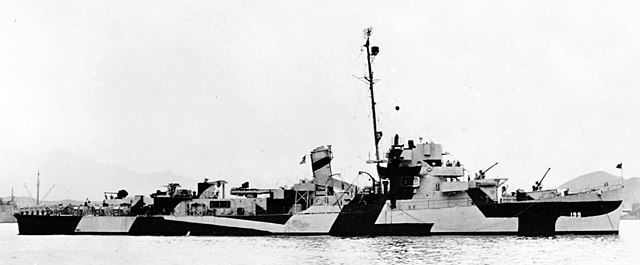 PACIFIC Submarine Cero (SS-225) attacks Japanese cargo ship No.18 Shinsei Maru while en route to Palau, 03°34'N, 136°36'E, but does not score any damage on her quarry. Submarine Grayback (SS-208) sinks Japanese army cargo ship Taikei Maru southwest of Takao, Formosa, 21°48'N, 119°50'E; subsequently, Grayback sinks army cargo ship Toshin Maru, 21°46'N, 120°06'E, which had arrived on the scene and rescued Taikei Maru's survivors. Submarine Jack (SS-259) attacks Japanese convoy of six tankers shepherded by escort vessel Shimushu in South China Sea about 300 miles west of Luzon, sinking merchant tankers Kokuei Maru and Nanei Maru, 14°34'N, 114°11'E; Nichirin Maru, 15°40'N, 115°48'E; and Ichiyo Maru 15°46'N, 115°57'E. USAAF B-25s (5th Air Force) sink auxiliary submarine chaser Cha 34 west of Kavieng, 02°45'S, 150°47'E; B- 25s, A-20s, and P-38s (5th Air Force) wipe out Japanese convoy O-902 off Kavieng, sinking submarine chasers Ch 22 and Ch 40, 03°04'S, 150°42'E, and cargo vessels No.1 Shinto Maru and Shinkiku Maru, 02°46'N, 150°42'E. USAAF B-24s and B-25s sink Japanese cargo vessel Ebon Maru at Kusaie. USAAF B-24s (14th Air Force) sink Japanese cargo ship Tairyu Maru and damage auxiliary submarine chaser Chikuzen Maru in Formosa Strait, 25°25'N, 121°30'E. Japanese cargo ship Kogen Maru is sunk in collision in Kii Channel, 35°00'N, 135°00'E.
|
|
lordroel
Administrator
Posts: 68,061 
Likes: 49,462
|
Post by lordroel on Feb 20, 2023 7:35:51 GMT
Day 1624 of World War II, February 20th 1944Eastern FrontThe Soviet 2nd Baltic Front launches a fresh set of attacks against the much-diminished German XVI Armee around Kholm. The Soviet 22nd Army makes good progress in the initial assault. Air War over Europe Mission 226: The Eighth Air Force begins "Big Week" attacks on German aircraft plants and airfields. For the first time, over 1,000 bombers are dispatched; 21 bombers and 4 fighters are lost hitting 3 areas in Germany. For the first time in the war, RAF and USAAF operations are coordinated. 1, - 417 B-17s are dispatched to Leipzig-Mockau Airfield, and aviation industry targets at Heiterblick and Abtnaundorf; 239 hit the primary targets, 37 hit Bernburg (Junkers), 44 hit Oschersleben (AGO, prime Fw 190A subcontractor) and 20 hit other targets of opportunity; they claim 14-5-6 Luftwaffe aircraft; seven B-17s are lost, one damaged beyond repair and 161 damaged; casualties are 7 KIA, 17 WIA and 72 MIA. 2,- 314 B-17s are dispatched to the Tutow Airfield; 105 hit the primary and immediate area, 76 hit Rostock (Heinkel) and 115 hit other targets of opportunity; they claim 15-15-10 Luftwaffe aircraft; 6 B-17s are lost, 1 damaged beyond repair and 37 damaged; casualties are 3 KIA and 60 MIA. 3,- 272 B-24s are dispatched to aviation industry targets at Brunswick, Wilhelmtor and Neupetritor; 76 hit the primary, 87 hit Gotha, 13 hit Oschersleben, 58 hit Helmstedt and 10 hit other targets of opportunity; they claim 36-13-13 Luftwaffe aircraft; 8 B-24s are lost, 3 damaged beyond repair and 37 damaged; casualties are 10 KIA, 10 WIA and 77 MIA. Missions one and three above are escorted by 94 P-38 Lightnings, 668 Eighth and Ninth Air Force P-47 Thunderbolts and 73 Eighth and Ninth Air Force P-51 Mustangs; they claim 61-7-37 Luftwaffe aircraft; one P-38 Lightning, two P-47 Thunderbolts and one P-51 Mustangs are lost, two P-47 Thunderbolts are damaged beyond repair and 4 other aircraft are damaged; casualties are 4 MIA. German losses amount to 10 Messerschmitt Bf 110s destroyed and three damaged with 10 killed and seven wounded. Total losses included 74 Bf 110s, Fw 190s and Bf 109s and a further 29 damaged. Mission 227: 4 of 5 B-17s drop 200 bundles of leaflets on Tours, Nantes, Brest and Lorient, France at 2123–2200 hours without loss. 35 B-26 Marauders bomb Haamstede Airfield, The Netherlands, as a target of opportunity, after about 100 B-26s abort attacks on other airfields because of weather. 156 RAF aircraft - 132 from training units and 24 from squadrons - flew a large training exercise across the North Sea as a preliminary feint; 24 Mosquitos attacked airfields in Holland; 7 Mosquitos made a diversionary raid on Munich and there were 7 Serrate patrols. No aircraft lost. Italian CampaignFifteenth Air Force B-24s blast troop concentrations in the Anzio, Italy beachhead area as the Axis efforts end. Twelfth Air Force B-26s hit troop concentrations along roads in the Vallalta area; B-25s hit dumps and assembly areas at the N edge of the Anzio beachhead, and A-20s bomb a troop and motor transport concentration SE of Carroceto; A-36s and P-40s hit troops, trucks and tanks NE of Carroceto, bomb the town of Fondi, a factory E of Carroceto, the town of Piedimonte, and hit guns and targets of opportunity along the N line of the beachhead; an Axis attempt to achieve a breakthrough is decisively defeated in the center of the salient created by a counteroffensive and their efforts end. Tank landing ship LST-348 is sunk by German submarine 'U-410', 40 miles south of Naples, Italy. The vessel was participating in the landings in Anzio-Nettuno. At 1755, 'U-230' fired one Gnat at landing ships off Anzio and heard a detonation after 13 minutes, 25 seconds. The Gnat probably detonated at the end of its run. At 1851 hours, another torpedo was fired, which sank HMS LST-305. Photo: Reverend G B Fairhurst, Padre of the 2/5th Queen's Regiment, talking to two of the men in his battalion and an American soldier in the Anzio bridgehead, 20-21 February 1944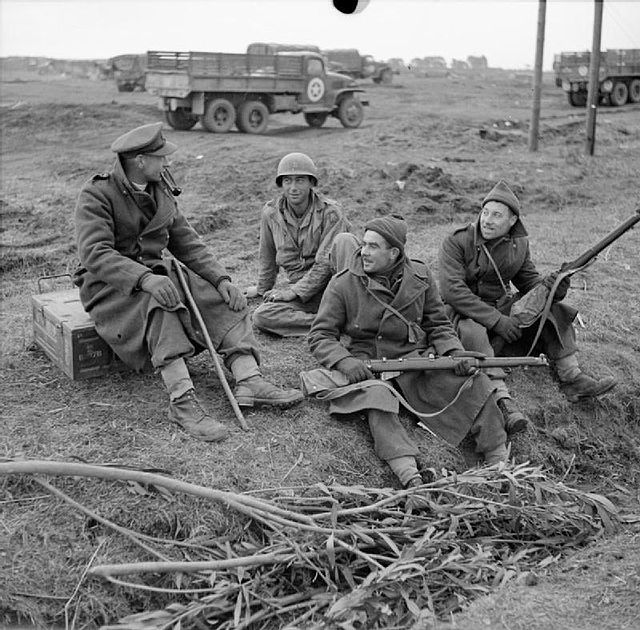 Battle of the Atlantic Battle of the Atlantic Whilst serving in Captain Walker’s renowned 2nd. Escort Group, sloop HMS 'Woodpecker' is hit by a Zaunkönig fired by 'U-764' (Leutnant zur See Hanskurt von Bremen) South of Iceland. 'Woodpecker’s' stern is blown off but as she remained afloat was taken in tow. She sank in a gale on 27 February. There were no casualties. VandW class destroyer HMS 'Warwick' is torpedoed and sunk by 'U-413' (Kapitanleutnant Gustav Poel) in the English Channel 20 SW of Trevose Head. The torpedo set off an internal explosion, whereupon 'Warwick' sank very quickly with 43 casualties and 93 survivors. German occupied NorwayNorwegian resistance successfully sinks a barge carrying heavy water from Ryukan, Norway bound for Germany. Heavy water is necessary for continued experiments by the German nuclear program. EgyptPresident Roosevelt and Winston Churchill, on their way back from the conference with Marshal Stalin in the Crimea, met for four hours at Cairo, Egypt to plan the next phase of the war against Japan. Mr Churchill told the US president that his government was "determined to throw everything it had at the Japanese." United StatesPhoto: The U.S. aircraft carrier USS Lexington (CV-16) after the repair of the torpedo damage sustained on 4 December 1943. The photo was probably taken on the day of the completion of her repairs, on 20 February 1944 Pacific War Pacific WarGILBERT AND MARSHALL ISLANDS CAMPAIGN In the Marshall Islands, aircraft the USS Enterprise, part of Task Group 58.1 bomb Japanese installations on Jaluit Atoll. BURMA-INDIA (Tenth Air Force): Bad weather limits operations to a routine patrol over Sumprabum, Burma. HQ 33d Fighter Group and 60th Fighter Squadron arrive at Karachi, India from Italy; they will be equipped with P-47Ds. PACIFIC OCEAN AREA (Seventh Air Force): 9 B-25s from Tarawa Atoll bomb the airfield at Wotje Atoll; P-40s from Makin strafe and bomb runways and small vessels at Mille Atoll. SOUTH PACIFIC AREA (Thirteenth Air Force): 35 B-25s, with fighter escort, pound Lakunai Airfield. P-39s attack barge traffic, which has greatly increased off SE and NW Bougainville Island, claiming 20 of the craft sunk. 18th Combat Mapping Squadron, 4th Photographic Group (Reconnaissance), is inactivated on Espiritu Santo Island. SOUTHWEST PACIFIC AREA (Fifth Air Force): In New Guinea, 38 B-24s bomb the Alexishafen to Hansa Bay area. 18 B-24s bomb the airfield at Laha, Ambon and 12 others hit shipping off Kavieng. Transfers in and out of New Guinea: HQ Fifth Air Force advance echelon and HQ V Bomber Command from Port Moresby to Nadzab; HQ 8th Fighter Group from Finschhafen to Cape Gloucester, New Britain Island; 498th Bombardment Squadron (Medium), 345th Bombardment Group (Medium), from Dobodura to Nadzab with B-25s. JAPANESE OCCUPIED NETHERLANDS EAST INDIES 18 Fifth Air Force B-24s bomb the airfield at Laha on Ambon Island. PACIFIC Submarine Pogy (SS-266) sinks Japanese cable layer Nanyo Maru about 100 miles east of Formosa, 24°12'N, 123°20'E, and merchant cargo ship Taijin Maru northeast of Formosa, 24°14'N, 123°17'E. USAAF B-24 damages Japanese cargo vessel Tasmania Maru northwest of Wewak.
|
|
lordroel
Administrator
Posts: 68,061 
Likes: 49,462
|
Post by lordroel on Feb 21, 2023 8:01:40 GMT
Day 1625 of World War II, February 21st 1944Eastern Front2nd Baltic Front continues its attacks capturing Soltsy and Kholm. To the south, 3rd Ukrainian Front continues its offensive threatening to surround Krivoi Rog. Continuation WarPhoto: Oulu People's House has been damaged in a bombing on 21st February 1944. The house was built in 1904 Air War over Europe Air War over Europe Mission 228: 3 areas in Germany are targeted with the loss of 16 bombers and 5 fighters: 1, - 336 B-17s are dispatched to the Gütersloh, Lippstadt and Werl Airfields; because of thick overcast, 285 hit Achmer, Hopsten, Rheine, Diepholz, Quakenbrück and Bramsche Airfields and the marshaling yards at Coevorden and Lingen; they claim 12-5-8 Luftwaffe aircraft; 8 B-17s are lost, 3 damaged beyond repair and 63 damaged; casualties are 4 KIA, 13 WIA and 75 MIA. 2, - 281 B-17s are dispatched to Diepholz Airfield and Brunswick; 175 hit the primaries and 88 hit Ahlhorn and Vörden Airfields and Hannover; they claim 2-5-2 Luftwaffe aircraft; five B-17s are lost, three damaged beyond repair and 36 damaged; casualties are 20 KIA, 4 WIA and 57 MIA. 3, - 244 B-24s are dispatched to Achmer and Handorf Airfields; 11 hit Achmer Airfield and 203 hit Diepholz, Verden and Hesepe Airfields and Lingen; they claim 5-6-4 Luftwaffe aircraft; 3 B-24s are lost, 1 damaged beyond repair and 6 damaged; casualties are three WIA and 31 MIA. Escort for Mission 228 is provided by 69 P-38s, 542 Eighth and Ninth Air Force P-47s and 68 Eighth and Ninth Air Force P-51s; the P-38s claim 0-1-0 Luftwaffe aircraft, 1 P-38 is damaged beyond repair; the P-47s claim 19-3-14 Luftwaffe aircraft, two P-47s are lost, two are damaged beyond repair, three are damaged and two pilots are MIA; the P-51s claim 14-1-4 Luftwaffe aircraft, three P-51s are lost and the pilots are MIA. German losses were 30 Bf 109s and Fw 190s, 24 pilots killed and seven wounded.[20] Mission 229: 5 of 5 B-17s drop 250 bundles of leaflets on Rouen, Caen, Paris and Amiens, France at 2215–2327 hours without loss. 17 RAF Mosquitos to Duisburg, Stuttgart and 2 flying-bomb sites, 1 Serrate patrol, 41 aircraft minelaying in the Frisians and off French ports, 10 OTU sorties. 1 Stirling minelayer lost. 18 B-26s bomb Coxyde Airfield, Belgium; weather causes almost 190 aborts. The Ninth Air Force's Pathfinder Squadron (provisionally activated on 13 Feb) takes part in this operation, its first venture into combat. 185 aircraft scheduled to attack other airfields in the Netherlands and France in the afternoon are recalled because of bad weather. Italian CampaignIn Italy, B-25s bomb Orte marshalling yard, and B-26s hit Imperia docks; A-20s pound troop concentrations near Campoleone, along with P-40s and A-36s which also hit a fuel dump, tank and truck concentrations, and gun positions in the area; fighter-bombers also bomb and block the Itri-Gaeta road. Photo: Men of the 2/7th Middlesex Regiment in one of their machine gun carriers at Anzio, 21 February 1944 Photo: Men of the 2/7th Middlesex Regiment carry out maintenance on a Vickers machine gun at Anzio, 21 February 1944 Photo: Men of the 2/7th Middlesex Regiment carry out maintenance on a Vickers machine gun at Anzio, 21 February 1944 United StatesPhoto: Russian naval officers inspecting 105mm at U.S. Assault Training Center. 21 February, 1944 United StatesPhoto: Russian naval officers inspecting 105mm at U.S. Assault Training Center. 21 February, 1944 Photo: The U.S. Navy aircraft carrier USS Franklin (CV-13) in the Elizabeth River, off Norfolk, Virginia (USA), on 21 February 1944. She is accompanied by three local harbor tugs. Franklin is painted in camouflage Measure 32, Design 6a. This paint scheme was changed a few months later, on the port side only, to Measure 32, Design 3a. The ship's starboard side retained the Design 6a pattern Photo: The U.S. Navy aircraft carrier USS Franklin (CV-13) in the Elizabeth River, off Norfolk, Virginia (USA), on 21 February 1944. She is accompanied by three local harbor tugs. Franklin is painted in camouflage Measure 32, Design 6a. This paint scheme was changed a few months later, on the port side only, to Measure 32, Design 3a. The ship's starboard side retained the Design 6a pattern Photo: View of the island of the U.S. Navy escort carrier USS Charger (CVE-30) on 21 February 1944. Note the mast structure, radars, rear admiral's flag, and signal balls. The SC radar is visible above the island, the YE homing beacon in the hightest antenna Photo: View of the island of the U.S. Navy escort carrier USS Charger (CVE-30) on 21 February 1944. Note the mast structure, radars, rear admiral's flag, and signal balls. The SC radar is visible above the island, the YE homing beacon in the hightest antenna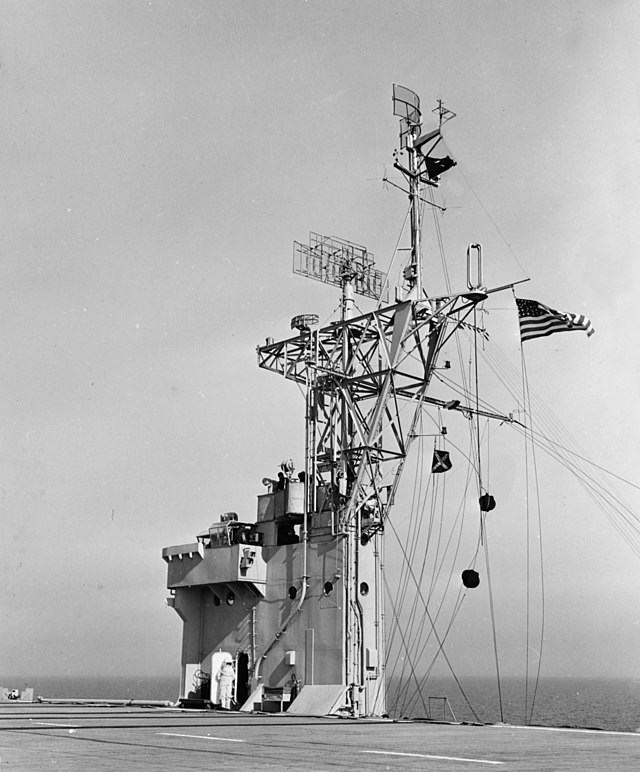 Pacific War Pacific WarBURMA-INDIA (Tenth Air Force): In Burma, 50+ P-51s and A-36s and a few B-25s hit a command post at Shingban, the town of Mohnyin, a bridge at Loilaw, a camp at Shaduzup, 2 bridges at Namkwin, and warehouses and other buildings at Kawlin and Wuntho; fighter-bombers attacking a fuel dump at Pin Hmi drop bombs in the wrong area; B-25s, escorted by RAF Spitfires and Hurricanes, score effective hits on a tunnel on the Maungdaw-Buthidaung road. CHINA The Chinese 8th Route Army takes Taiku, China. PACIFIC OCEAN AREA (Seventh Air Force): B-24s from Tarawa Atoll and Abemama Island hit Ponape and Kusaie Islands and Jaluit Atoll. B-25s from Abemama bomb Maloelap Atoll. P-40s from Makin hit Mille Atoll. US forces gain complete control of Eniwetok Island. 9th Troop Carrier Squadron, Seventh Air Force, arrives at Hickam Field, Territory of Hawaii from the US with C-47s. SOUTH PACIFIC AREA (Thirteenth Air Force): 15 B-24s bomb Lakunai Airfield; 4 others, with fighter support, attack the airfield at Rapopo; 20 P-38s join USN fighters in covering a USN dive bomber strikes on Lakunai gun positions. In the Bougainville Island area 3 B-24s bomb Kara Airfield while P-39s hit buildings at Tsundawan and in the area S of Tabut, and bomb barges and jetty in the Matchin Bay area. SOUTHWEST PACIFIC AREA (Fifth Air Force): Almost 30 A-20s hit Madang and the Hansa Bay area. On New Britain Island, P-39s hit Raiven Plantation; 40+ B-24s bomb the Rein Bay and Eleonora Bay areas; others attack shipping off New Hanover Island. Lost on a transport flight is B-25D 41-30374. Crashed in an emergency landing attempt is L-5A "Termite" 42-98085. NEW GUINEA CAMPAIGN Photo: A line up of Vultee Vengeance dive bomber aircraft of No. 21 Squadron RAAF in the dispersal area of Nadzab airdrome, Markham Valley, Morobe Province, Papua New Guinea. In the foreground is aircraft coded MJ-N, RAAF s/n A27-60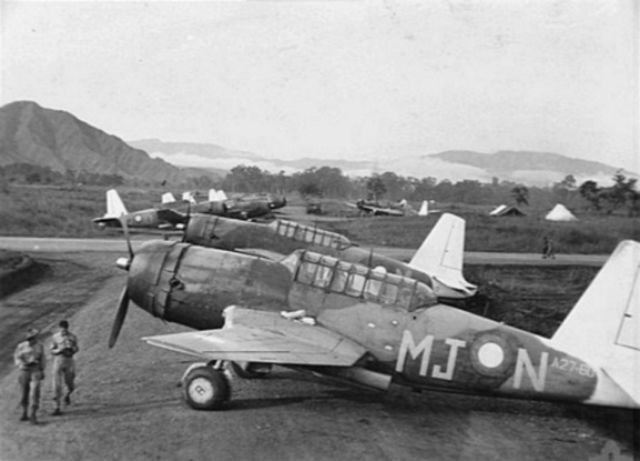 JAPAN The Japanese prime minister, General Hideki Tojo, today sacked the heads of the Japanese army and navy following last week's catastrophic losses to the Allies at Truk. Japan's strategic outlying defence base in the South-west Pacific. General Tojo, who takes over as chief of the army general staff, succeeding the disgraced General Sugiyama, is being accused of running a one-man cabinet. In addition to being premier, he is minister of war, controller of munitions, minister of commerce and industry, and minister of education. A protest has been issued by one of the emperor's brothers, Imperial Prince Chichibu, and dissident general staff officers have nicknamed Tojo "Takauji"- a reference to a 14th century military upstart. PACIFIC Navy SBDs and TBFs bomb antiaircraft positions at Lakunai aerodrome and shore installations at Rabaul, sinking guardboat No.2 Yawata Maru. USAAF B-25s (5th Air Force) strike Japanese five-ship convoy (evacuating 751st Air Group maintenance people to Japan, via Palau) off New Hanover, sinking auxiliary submarine chasers Cha 38 and Cha 48, 02°30'S, 149°55'E, transport Kokai Maru and gunboat Kowa Maru, 02°30'S, 150°15'E, and damaging tug Nagaura, which, after effecting repairs, rescues some of the survivors of the two Marus and continues on her voyage north (see 22 February). Submarine Cero (SS-225) damages Japanese army cargo ship Hasshu Maru north of New Guinea, 00°10'S, 139°45'E. British submarine HMS Tally Ho sinks Japanese army cargo ship No.6 Taigen Maru in Strait of Malacca, 04°00'N, 101°00'E.
|
|
lordroel
Administrator
Posts: 68,061 
Likes: 49,462
|
Post by lordroel on Feb 22, 2023 3:46:41 GMT
Day 1626 of World War II, February 22nd 1944Eastern Front German forces avoid the fate of their comrades at Korsun as they make a hasty retreat from Krivoi Rog before the Red Army pincers could slam shut. 3rd Ukrainian Front enters the city. Photo: Soviet troops entering Krivoy Rog during its liberation in February 1944 Air War over Europe Air War over EuropeMission 230: "Big Week" continues with 799 aircraft dispatched against German aviation and Luftwaffe airfields; 41 bombers and 11 fighters are lost. 1, - 289 B-17s are dispatched against aviation industry targets at Aschersleben (34 bomb), Bernburg (47 bomb) and Halberstadt (18 bomb) in conjunction with a Fifteenth Air Force raid on Regensburg, Germany; 32 hit Bünde, 19 hit Wernigerode, 15 hit Magdeburg, 9 hit Marburg and 7 hit other targets of opportunity; they claim 32-18-17 Luftwaffe aircraft; 38 B-17s are lost, 4 damaged beyond repair and 141 damaged; casualties are 35 KIA, 30 WIA and 367 MIA. 2, - 333 B-17s are dispatched to Schweinfurt but severe weather prevents aircraft from forming properly and they are forced to abandon the mission prior to crossing the enemy coast; 2 B-17s are damaged. 3, - 177 B-24s are dispatched but they are recalled when 100 miles (160 km) inland; since they were over Germany, they sought targets of opportunity but strong winds drove the bombers over The Netherlands and their bombs hit Enschede, Arnhem, Nijmegen and Deventer; they claim 2-0-0 Luftwaffe aircraft; 3 B-24s are lost and 3 damaged; casualties are 30 MIA. About 900 civilians were killed, mainly in the bombing of Nijmegen. These missions are escorted by 67 P-38s, 535 Eighth and Ninth Air Force P-47s, and 57 Eighth and Ninth Air Force P-51s; the P-38s claim 1 Luftwaffe aircraft destroyed, 1 P-38 is damaged beyond repair and 6 are damaged; the P-47s claim 39-6-15[clarification needed] Luftwaffe aircraft, 8 P-47s are lost and 12 damaged, 8 pilots are MIA; the P-51s claim 19-1-10 Luftwaffe aircraft, 3 P-51s are lost and 3 damaged, 3 pilots are MIA. B-17s attack Petershausen marshaling yard and Regensburg aircraft factory in Germany and the air depot at Zagreb, Yugoslavia; a large force of B-24s hits Regensburg aircraft plants about the same time as the B-17 attack; other B-24s pound the town of Sibenik and the harbor at Zara, Yugoslavia; they claim 40 Luftwaffe aircraft destroyed; 13 bombers are lost. 66 Ninth Air Force B-26s bomb Gilze-Rijen Airfield, The Netherlands; bad weather causes 100+ others to abort. 10 RAF Mosquitos went to Stuttgart, 8 to Duisburg and 3 to Aachen, 71 Halifaxes and 40 Stirlings sent minelaying off North German coast recalled because of bad weather at bases, 2 RCM sorties, 2 Serrate patrols. No aircraft lost. The Luftwaffe mounts a large raid on the UK. HQ VIII Bomber Command is redesignated as HQ, Eighth Air Force. Italian CampaignIn Italy, US Twelfth Air Force B-25s bomb Foligno marshalling yard and Montalto di Castro railroad bridge, and B-26s attack Albinia Station railroad bridge; A-20s hit the area E of Campoleone; P-47s strike troops, gun positions, and a road junction N of Carroceto, roads near Roccasecca, and the town of Campoleone; A-36s hit guns NW of Carroceto and the town of Formia; P-40s attack guns SE of Campoleone. Five German E-boats approach Anzio beachhead during the night, but all are driven off without inflicting any damage. Submarine chaser PC-621 claims destruction of one E-boat and drives another ashore. Battle of the Atlantic An RCAF 162 Sqn Catalina attacked 'U-550' with machine guns in the North Atlantic. Two crewmembers were killed. Battle of the MediterraneanUS Fifteenth Air Force B-17s attack Petershausen marshalling yard and Regensburg aircraft factory in Germany and the air depot at Zagreb, Yugoslavia; a large force of B-24s hits Regensburg aircraft plants about the same time as the B-17 attack; other B-24s pound the town of Sibenik and the harbor at Zara, Yugoslavia; they claim 40 Luftwaffe aircraft destroyed; 13 bombers are lost. German submarine 'U-969' attacks convoy GUS 31 off the coast of Algeria, irreparably damaging U.S. freighters 'Peter Skene Ogden' and 'George Cleeve'; other than one fatality on board the former, there are no casualties to the American ships. The survivors were picked up by the American SS 'William T. Barry' after 30 minutes and landed in Oran. Both ships are towed and beached to facilitate salvage: 'Peter Skene Ogden' at Herbillon and 'George Cleeve' to Bone, Tunisia. Both are later written off as total losses. 400 German soldiers drowned when their train was blown into a flooded river at Athens by mines laid by British led Greek partisans. Hundreds more were injured. A general was amongst the dead. The ambush marks a new offensive in the Balkans, with British officers from the Special Operations Executive leading Andarte freedom fighters. Ten coaches plunged down a ravine on the main Athens to Salonika line. The surviving armoured coach was sprayed with machine gun fire before the partisans disappeared into the countryside. Battle of the CaribbeanPhoto: The U.S. Navy aircraft carrier USS Wasp (CV-18) underway at sea in the vicinity of Trinidad, with planes parked forward, apparently in preparation for landing aircraft, 22 February 1944 Sweden SwedenSoviet bombers attack Stockholm by mistake. There are no casualties. Photo: From the Soviet bombing of the Eriksdal area at Södermalm, Stockholm, Sweden Pacific War Pacific WarGILBERT AND MARSHALL ISLANDS CAMPAIGN Marines land on Parry Island, Eniwetok Atoll, under cover of naval bombardment and carrier-aircraft bombing; this operation completes U.S. control of Eniwetok Atoll. Infantry landing craft LCI-365, LCI-440, and LCI-442 are damaged by friendly fire. MARIANA AND PALAU ISLANDS CAMPAIGN TF 58 (Rear Admiral Marc A. Mitscher) planes bomb Saipan, Tinian, Rota, and Guam, in first strike against the Marianas. TF 58 planes sink Japanese transport Shoan Maru off Saipan, 15°15'N, 145°42'E; planes from TG 58.2 and TG 58.3 sink transport Seizan Maru off Saipan, 15°00'N, 145°30'E. BURMA-INDIA (Tenth Air Force): 70+ B-25s, P-51s, and P-40s again hit a variety of targets in Burma; bridges are severely damaged or put out of use at Zawa, Tindeinyan, Ye-u, Namkwin, and Loilaw; warehouses and supply dumps are hit at Segyi and at Chantha, and the Pahok road and railroad junction are blasted; also hit are targets of opportunity at Kawlum and along the Walawbum-Kamaing road. CHINA (Fourteenth Air Force): P-40s on armed reconnaissance strafe the airfield at Kengtung, China and nearby truck convoy. At Bhamo, Burma a large rivercraft is hit and left sinking. PACIFIC OCEAN AREA (Seventh Air Force): 1 B-24 bombs Kusaie Island. 8 A-24s and 9 P-40s from Makin bomb Mille Atoll; 1 P-40 launches rockets against airfield targets in the first such attack by a Seventh Air Force aircraft. SOUTH PACIFIC AREA (Thirteenth Air Force): 20 P-40s and 40+ USN fighters cover 70 USN dive bombers attacking Keravia Bay shipping; 40+ B-24s, with fighter escorts, bomb Lakunai and Keravat Airfields. 370th Bombardment Squadron (Heavy), 307th Bombardment Group (Heavy), moves from Guadalcanal to Munda with B-24s. SOUTHWEST PACIFIC AREA (Fifth Air Force): 30+ B-25s and P-39s attack the Madang area. 60+ B-25s and B-24s pound Iboki Plantation on New Britain Island in support of US Marines (USMC) advancing on the area from Natamo (and who capture Perry Island). 319th Bombardment Squadron (Heavy), 90th Bombardment Group (Heavy), moves from Dobodura to Nadzab, New Guinea with B-24s. PACIFIC TG 39.4 (Captain Arleigh A. Burke) bombards Japanese airstrips, pier area, and anchorages at Kavieng; destroyers Charles Ausburne (DD-570), Dyson (DD-572), and Stanly (DD-478) sink Japanese minelayer Natsushima off New Ireland, 02°40'S, 149°40'E; the same three destroyers, joined by Conway (DD-507) and Spence (DD-512), sink tug Nagaura about 160 miles northwest of Kavieng, 00°54'S, 148°38'E. Other Japanese ships sunk during this action include auxiliary submarine chaser No.8 Tama Maru and small cargo vessels Choryu Maru and No.9 Tokuyama Maru. Destroyer Division 45 sinks Japanese auxiliary netlayer Kyosei Maru in Isabel Channel, New Hanover. Submarine Gato (SS-212) sinks Japanese repair ship Yamashiro Maru off Truk, 07°13'N, 151°38'E. Submarine Puffer (SS-268), despite presence of escort vessel, sinks Japanese army transport Teiko Maru (ex- French passenger liner D'Artagnan) about 120 miles northwest of Kuching, Borneo, 03°10'N, 109°15'E. Submarine Ray (SS-271) lays mines off Saigon, French Indochina. Submarine Tang (SS-306), in attack on Japanese convoy, sinks gunboat Fukuyama Maru about 60 miles southwest of Saipan, 15°14'N, 144°55'E. Japanese auxiliary submarine chaser Cha 29 is sunk by mine (possibly laid by submarine Silversides (SS-236) on 4 June 1943) near Kavieng. Navy SBD and TBF aircraft pound Japanese shipping in Keravia Bay, Rabaul, sinking guardboats No.2 Fuku Maru and No.2 Tenjin Maru, army cargo ship Taisho Maru, merchant tanker Takatori Maru, and damaging minelayer Nasami. Vichy French river gunboat Francis Garnier is sunk by mine sown by USAAF planes (14th Air Force) in South China Sea off Cape St. Jacques, French Indochina, 10°30'N, 108°00'E.
|
|
lordroel
Administrator
Posts: 68,061 
Likes: 49,462
|
Post by lordroel on Feb 23, 2023 3:49:34 GMT
Day 1627 of World War II, February 23rd 1944Eastern FrontThe 2nd Baltic and Volkhov Fronts continue their offensive in northern Russia capturing Strugi Krasneyye and 1st Belorus Front drives toward Dno. Air War over Europe Mission 232: 5 of 5 B-17s drop 250 bundles of leaflets on Rennes, Le Mans, Chartres, Lille and Orleans, France at 21:36–22:32 hours without loss. US Fifteenth Air Force B-24s bomb the industrial complex at Steyr, Austria. Other heavy bombers are forced to abort because of bad weather; the bombers and escorting fighters claim 30+ aircraft shot down. Oblt. Walther Dahl of III./JG 3 shot down 2 four-engined bombers and a P-38 to bring his score to 61 kills. 17 RAF Mosquitos to Düsseldorf, 2 Serrate patrols, 3 OTU sorties. No aircraft lost. A Mosquito of No. 692 Squadron RAF dropped a 4,000-lb bomb on Düsseldorf. This is double the original bombload of the Mk IV. To carry this large device, the bomb-bay is bulged. The Mosquitos of the Light Night Striking Force regularly carried such heavy bombs during the remaining months of the war to targets as far distant as Berlin. A Do 217 night-fighter made a perfect belly-landing near Cambridge after its crew bailed out over London and delivered to the Allies a near- perfect example of a German night-fighter. The plane was soon used for RAF purposes. Italian CampaignGeneral Lucian Truscott takes full command of VI Corps at Anzio, replacing General Lucas as the Germans regroup for a fresh series of counterattacks against the beleaguered troops. In Italy, P-40s hit a gun position N of Campoleone and patrol the Anzio area. Weather prevents other operations. Battle of the Atlantic 'U-257' is sunk in the North Atlantic, by depth charges from frigates HMCS 'Waskesiu' and HMS 'Nene'. 30 dead and 19 survivors. According to a crewmember on the HMCS 'Waskesiu' the HMS 'Nene' only participated in picking up survivors while the Canadian frigate dropped the depth charges, after both frigates had picked up an ASDIC signal that the Canadians insisted was a U-boat, which sank the boat. Battle of the Indian Ocean U.S. tanker E.G. Seubert, in convoy PA 69, is torpedoed and sunk by German submarine U-510 about 200 miles fromAden, 13°45'N, 48°56'E; three of the 27-man Armed Guard (including its commander) perish, as do three of the ship's merchant complement. Australian minesweeper HMAS Tamworth and Indian Navy corvette RINS Orissa rescue survivors. United StatesPhoto: The U.S. Navy destroyer escort USS Doherty (DE-14) underway off the Mare Island Naval Shipyard, California (USA), on 23 February 1943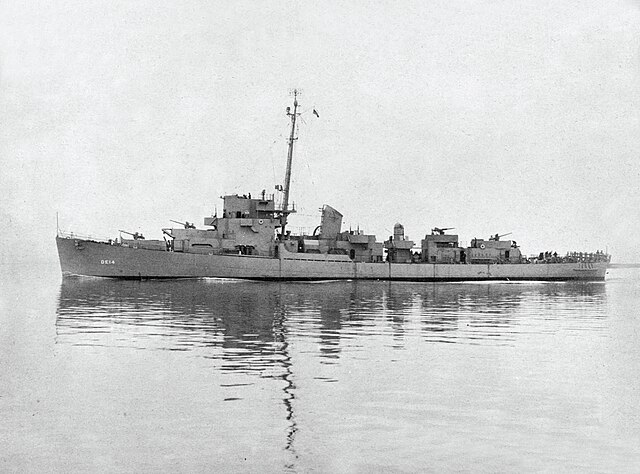 Pacific War Pacific WarBURMA-INDIA (Tenth Air Force): In Burma, 14 B-24s bomb airfields and other targets at Akyab and Dabaing; 3 B-25s and 12 P-51s hit a radio station at Man Pang; 4 other P-51s hit warehouses at Chantha. CHINA (Fourteenth Air Force): 4 B-25s attack 2 ships in the Gulf of Tonkin and hit railroad cars and engine shed at Van Trai Station, French Indochina. 4 P-40s strafe Lashio Airfield, Burma. PACIFIC OCEAN AREA (Seventh Air Force): P-40s from Makin bomb Mille Atoll; 2 small boats are destroyed by strafing; B-25s from Abemama hit Taroa. B-24s from Makin and Tarawa Atoll bomb Kusaie and Ponape Islands and Jaluit Atoll. SOUTH PACIFIC AREA (Thirteenth Air Force): 4 B-24s on armed reconnaissance strafe the Cape Saint George area and bomb buildings and pier at Labur Bay and 4 B-24s attack bivouacs in the upper Saua River area. 9 B-25s, with USN fighter support, bomb Vunakanau Airfield; 10 other B-25s hit Keravat Airfield; 16 P-38s dive-bomb the Vunapope supply area and some attack the town of Rabaul; this is the first P-38 bombing raid on the Rabaul area; (P-38s, now free from constant responsibility of guarding bombers against interceptors, will continue to dive-bomb the Rabaul area through Apr 44; during the latter part of this campaign against the famed Japanese garrison, which is to be bypassed by Allied ground forces, P-39s will add their strength due to completion of an airstrip on Nissan Island in the Green Islands; by 20 Apr only 120 of 1400 buildings in Rabaul will still be standing). SOUTHWEST PACIFIC AREA (Fifth Air Force): Almost 50 A-20s and B-24s blast the airfield, buildings, and AA positions in the Wewak, New Guinea area. Units moving from Dobodura to Nadzab, New Guinea: HQ 90th Bombardment Group and 320th, 321st and 400th Bombardment Squadrons with B-24s; 500th and 501st Bombardment Squadron (Medium), 345th Bombardment Group (Medium), with B-25s. MARIANA AND PALAU ISLANDS CAMPAIGN During strikes on Japanese shipping in Tanapag harbor, Saipan, F6Fs, TBFs and SBDs from carriers Essex (CV-9) and Yorktown (CV-10) (in TG 58.2) damage cargo ship Shoan Maru, 15°15'N, 145°45'E; planes from carrier Bunker Hill (CV-17) (in TG 58.3) sink cargo vessel Seizan Maru off Tinian, 15°00'N, 145°30'E. Photo: A Japanese bomber flies through tracers and "flak" bursts just aft of the U.S. Navy light aircraft carrier USS Belleau Wood (CVL-24), during an attack on Task Group 58.2 off the Mariana Islands, 23 February 1944. The plane crashed and exploded a few seconds later, missing the ship. The photo was taken from USS Essex (CV-9) PACIFIC Submarine Balao (SS-285), in attack on Japanese convoy about 35 miles north of Biak, New Guinea, sinks army cargo ship Nikki Maru, 00°11'S, 135°00'E. Submarine Cod (SS-224) sinks Japanese fleet tanker No.3 Ogura Maru off Halmahera, 04°23'N, 129°05'E. Submarine Plunger (SS-179), in attack on Japanese convoy, sinks transport Kimishima Maru about 200 miles northwest of Chichi Jima, 30°11'N, 140°49'E. Submarine Pogy (SS-266) attacks Japanese convoy, sinking merchant cargo ship Horei Maru, 26°20'N, 126°11'E, and damaging merchant tanker Teikon Maru, 26°22'N, 126°16'E, about 60 miles west of Okinawa. Submarine Snook (SS-279) attacks Japanese convoy, sinking transport Kayo Maru about 120 miles north- northwest of Chichi Jima, 28°49'N, 141°13'E. Submarine Sunfish (SS-281) and planes from carrier Yorktown (CV-10) sink Japanese collier Shinyubari Maru about 40 miles west of Saipan, 15°23'N, 145°03'E. Submarine Tang (SS-306) sinks Japanese repair ship Yamashimo Maru west of Saipan, 14°45'N, 144°32'E. The cataclysmic explosion of the enemy auxiliary damages Tang, but not badly enough to prevent the boat from remaining on patrol. Japanese gunboat Eiko Maru is sunk by aircraft north of Saipan, 15°12'N, 144°52'E, as she proceeds to the position of the loss of Fukuyama Maru that had been sunk by Tang (SS-306) on 22 February. Japanese cargo ship Gyoko Maru is destroyed by accidental explosion in Naha harbor, Okinawa, 26°13'N, 127°40'E.
|
|
lordroel
Administrator
Posts: 68,061 
Likes: 49,462
|
Post by lordroel on Feb 24, 2023 8:27:37 GMT
Day 1628 of World War II, February 24th 1944Eastern Front1st Belorus Front captures Dno while 2nd Beloruss Front took Rogachev. Continuation WarThe prime minister of Finland says that Finland is prepared to make peace immediately with Russia, subject to conditions. Air War over Europe 734 RAF aircraft - 554 Lancasters, 169 Halifaxes, 11 Mosquitos - carried out the first Bomber Command raid on Schweinfurt, home of Germany's main ball-bearing factories. 266 American B-17s had raided the factories the previous day. Bomber Command introduced a novel tactic on this night. The Schweinfurt force was split into two parts - 392 aircraft and 342 aircraft, separated by a 2-hour interval. Part of the German fighter force was drawn up by earlier diversions. The first wave of the Schweinfurt bombers lost 22 aircraft, 5.6 per cent; the second wave lost only 11 aircraft, 3.2 per cent, and it is believed that only 4 bombers from the second wave were shot down by night fighters. Total losses were 33 aircraft - 26 Lancasters, 7 Halifaxes - 4.5 per cent of the force. Martin Becker of 2./NJG 6 destroyed a Halifax to reach 19 kills. 179 RAF training aircraft on a diversionary sweep over the North Sea, 60 Halifaxes and 50 Stirlings minelaying in Kiel Bay and the Kattegat, 15 Mosquitos to airfields in Holland, 8 Mosquitos to Kiel and 7 to Aachen, 12 Serrate patrols. 2 Stirlings were lost from the minelaying operation and 1 Serrate Mosquito of No 141 Squadron was lost, the first Serrate aircraft to be lost under Bomber Command control. 5 Wellingtons laid mines off Lorient without loss. Mission 237: 49 of 81 B-24s hit the Ecalles sur Buchy V-weapon sites; 1 B-24 is damaged. Escort is provided by 61 P-47s. Mission 238: 258 B-17s are dispatched against V-weapon sites in the Pas de Calais; 109 hit the primary target, 10 hit a road junction E of Yerville, 7 hit a rail siding SW of Abbeville and 6 hit targets of opportunity; 7 B-17s are lost and 75 damaged; casualties are 5 WIA and 63 MIA. Escort is provided by 81 P-38s, 94 P-47s and 22 P-51s; 1 P-38 is damaged beyond repair; the P-51s claim a single German aircraft on the ground. Mission 239: 5 of 5 B-17s drop 250 bundles of leaflets on Amiens, Rennes, Paris, Rouen and Le Mans, France at 2023–2055 hours without loss. 180 B-26s attack NOBALL (V-weapon) targets and Rosieres-en-Santerre, France. Bad weather makes bombing difficult and causes 34 other B-26s to abort. Italian CampaignIn Italy, US Twelfth Air Force B-25s attack Canino landing ground, but clouds prevent accurate bombing and most bombs fall W and SW of the main target area; A-36s attack airfields at Littoria, Guidonia and Marciglialia. P-47's hit motor vessels and tug off Dubrovnik, Yugoslavia and targets of opportunity inland. Battle of the Atlantic 'SS Philipp M' (2,085t) cargo ship, Tyne to London with coal, was sunk by an E Boat, off Great Yarmouth. Battle of the MediterraneanGerman submarine 'U-761' was detected by PBY-5A Catalinas from VP-63, now based at Naval Air Facility (NAF) Port Lyautey, French Morocco, during an attempt to pass through the Straits of Gibraltar. The two VP-63 aircraft used their MAD gear to detect, track, and assist in the sinking of 'U-761', the first sinking of a submarine aided by MAD equipment. The U-boat was attacked by an RAF Catalina Mk. IB of No. 202 Squadron, based at Gibraltar, and a PV-1 Ventura of USN Bombing Squadron One Hundred Twenty Seven (VB-127) also based at NAF Port Lyautey. The crew of the VB-127 Ventura, assisted in the kill by dropping depth charges on 'U-761' when it surfaced. Following the attack by VB-127 PV-1, the U-boat was scuttled in the mid-Atlantic near Tangier in view of approaching British destroyers. Nine of the 57 men aboard were lost; the 48 survivors, including the captain, were picked up by HMS 'Anthony' and HMS 'Wishart'. United States Photo: The U.S. Navy aircraft carrier USS Shangri-La (CV-38) is christened by Mrs. Josephine "Joe" E. Doolittle, wife of (then) U.S. Army Air Forces Major General James H. Doolittle, during launching ceremonies at the Norfolk Navy Yard, Virginia (USA), 24 February 1944. Rear Admiral Felix X. Gygax, the Navy Yard Commandant, is in the foreground, holding a microphone close to the sponsor's champagne bottle as it smashes into the new carrier's bow Photo: Launch of the U.S. Navy aircraft carrier USS Shangri-La (CV-38) at the Norfolk Naval Shipyard, Virginia (USA), on 24 February 1944 Photo: Launch of the U.S. Navy aircraft carrier USS Shangri-La (CV-38) at the Norfolk Naval Shipyard, Virginia (USA), on 24 February 1944 Photo: The U.S. Navy destroyer USS Morrison (DD-560) off Point No Point, Washington (USA), 24 February 1944. The ship is painted in Camouflage Measure 32, Design 13D Photo: The U.S. Navy destroyer USS Morrison (DD-560) off Point No Point, Washington (USA), 24 February 1944. The ship is painted in Camouflage Measure 32, Design 13D Photo: The U.S. Navy high-speed transport USS Crosby (APD-17) off the Mare Island Naval Shipyard, California (USA), on 24 February 1943, following conversion to a high-speed transport Photo: The U.S. Navy high-speed transport USS Crosby (APD-17) off the Mare Island Naval Shipyard, California (USA), on 24 February 1943, following conversion to a high-speed transport Pacific War Pacific WarBURMA-INDIA (Tenth Air Force): In Burma, 6 B-25s hit bridges and trains between Pintha and Kinu; 1 bridge is damaged and several boxcars are destroyed; 13 B-24s bomb the marshalling yard at Mandalay and targets of opportunity at Akyab, Monywa, and Pakokku; P-51s, A-36s and P-40s attack bridges, radio stations, supply dumps, bivouacs, troop concentrations, railroad by-passes, AA positions, and other targets at Seton, Sinkan, Ye-u, Kawlin, Loilaw, Namkwin, Shaduzup, and the Mogaung-Kamaing area. CHINA (Fourteenth Air Force): 6 P-40s on armed reconnaissance strafe the airfield at Myitkyina, Burma. PACIFIC OCEAN AREA (Seventh Air Force): P-40s from Makin strafe and bomb the runway and radio installation on Mille Atoll; B-25s from Tarawa Atoll pound the airfield on Wotje Atoll. SOUTH PACIFIC AREA (Thirteenth Air Force): On New Britain Isladn, 22 B-25s, with fighter escort, pound Rabaul; 9 minutes later 12 P-38s glide-bomb Rabaul; 2 minutes afterward 11 B-24s pound the same target; 6 other B-24s bomb Rapopo; P-40s and USN fighters escort USN dive bombers in a strike on Vunapope; P-39s attack Monoitu Mission. 394th Bombardment Squadron (Heavy), 5th Bombardment Group (Heavy), based on Guadalcanal Island with B-24s, begines operating from Munda. SOUTHWEST PACIFIC AREA (Fifth Air Force): In New Guinea, 23 B-24s and 39 A-20s thoroughly pound the Hansa Bay area. Nearly 20 other B-24s bomb Nubia and Awar Airfields. In preparation for the Allied landing, 50+ B-25s and B-24s pound Momote, Lorengau on Manus and other targets in the Admiralty Islands. 80th Fighter Squadron, 8th Fighter Group, moves from Dobodura to Cape Gloucester with P-38s. ALASKA (Eleventh Air Force): 3 B-24s from Shemya search for enemy shipping; 1 B-24 crashes during takeoff, the others find nothing. PACIFIC Destroyers Buchanan (DD-484) and Farenholt (DD-491) are damaged by shore battery, north of New Ireland, 02°20'S, 151°02'E. Submarine Grayback (SS-208) sinks Japanese oiler Nanho Maru about 20 miles east of Formosa, 24°20'N, 122°25'E, and damages transport Asama Maru, 24°15'N, 122°19'E. Escort vessel Shimushu's counterattack is ineffective. Submarine Pogy (SS-266) bombards phosphate plant on Rasa Island. Submarine Sand Lance (SS-381) is damaged by ice and heavy seas, Kurils. Submarine Tang (SS-306), in attack on Japanese convoy west of Saipan, sinks merchant cargo ship Echizen Maru, 15°45'N, 143°29'E. USAAF B-25s, P-40s, and P-38s hit targets of opportunity along the Yangtze, damaging Japanese guardboat Yoko Maru. U.S. aircraft sink Japanese transport No.2 Shunzan Maru off Kusaie, Carolines, 05°20'N, 162°58'E. British submarine HMS Tally Ho damages Japanese torpedo boat Kari in Strait of Malacca.
|
|
lordroel
Administrator
Posts: 68,061 
Likes: 49,462
|
Post by lordroel on Feb 25, 2023 14:54:38 GMT
Day 1629 of World War II, February 25th 1944YouTube (Tojo Takes Control)Air War over EuropeMission 235: In the final "Big Week" mission, 4 targets in Germany are hit; 31 bombers and 3 fighters are lost. 1, - 268 B-17s are dispatched to aviation industry targets at Augsburg and the industrial area at Stuttgart; 196 hit Augsburg and targets of opportunity and 50 hit Stuttgart; they claim 8-4-4 Luftwaffe aircraft; 13 B-17s are lost and 172 damaged; casualties are 12 WIA and 130 MIA. 2, - 267 of 290 B-17s hit aviation industry targets at Regensburg and targets of opportunity; they claim 13-1-7 Luftwaffe aircraft; 12 B-17s are lost, 1 damaged beyond repair and 82 damaged; casualties are 4 KIA, 12 WIA and 110 MIA. 3, - 172 of 196 B-24s hit aviation industry targets at Furth and targets of opportunity; they claim 2-2-2 Luftwaffe aircraft; 6 B-24s are lost, 2 damaged beyond repair and 44 damaged; casualties are 2 WIA and 61 MIA. Escort is provided by 73 P-38s, 687 Eighth and Ninth Air Force P-47s and 139 Eighth and Ninth Air Force P-51s; the P-38s claim 1-2-0 Luftwaffe aircraft, 1 P-38 is damaged beyond repair; the P-47s claim 13-2-10 Luftwaffe aircraft, 1 P-47 is lost and 6 damaged, 1 pilot is MIA; the P-51s claim 12-0-3 Luftwaffe aircraft, 2 P-51s are lost and 1 damaged beyond repair, 2 pilots are MIA. Mission 236: 5 of 5 B-17s drop 250 bundles of leaflets on Grenoble, Toulouse, Chartres, Caen and Raismes, France at 2129–2335 hours without loss 594 RAF aircraft - 461 Lancasters, 123 Halifaxes, 10 Mosquitos - on the first large raid to Augsburg. The various diversions and the splitting of the main bomber force into 2 waves again reduced casualties still further. 21 aircraft - 16 Lancasters, 5 Halifaxes - lost, 3.6 per cent of the force; at least 4 of these casualties were due to collision. The bombing at Augsburg was outstandingly successful in clear weather conditions and against this 'virgin' target with only weak flak defences. The Pathfinder ground-marking was accurate and the raid became controversial because of the effects of its outstanding accuracy. Serious damage is done to the engineering works and aircraft components factory. 85,000 people are made homeless. The beautiful old centre of Augsburg was completely destroyed by high explosive and fire, with much less than the usual spread of bombing to the more modern outer areas, where some industry was located. There were 246 large or medium fires and 820 small ones; the temperature was so cold (minus 18" Celsius) that the River Lech was frozen over and many of the water hoses also froze. The Germans publicized it as an extreme example of 'terror bombing'. 191 B-26 Marauders bomb Venlo, Saint-Trond, and Cambrai/Epinoy Airfields, France in a morning raid as a diversion in support of the VIII Bomber Command heavy bombers over Germany; 36 abort, mainly because of a navigational error; 164 B-26s dispatched against military targets in France during the afternoon are recalled because of bad weather. Major General Paul L Williams becomes Commanding General of the Ninth Air Force's IX Troop Carrier Command. 131 RAF aircraft minelaying in Kiel Bay, 22 Mosquitos to airfields in Holland, 15 Mosquitos on diversionary raids to 4 towns to the north of the Augsburg routes, 5 RCM sorties, 10 Serrate patrols. 3 Halifaxes and 1 Stirling lost from the minelaying operation. Italian CampaignThe destroyer HMS ''Inglefield' is sunk at dusk off Anzio by a Hs293A Glide bomb and sinks very rapidly off Anzio. There are 35 casualties and 157 survivors. In Italy, US Twelfth Air Force P-40s attack guns and troop concentrations east of Campoleone and in the Carroceto area; A-36 Apaches bomb the towns of Terracina and Sperlonga and roads in the area; P-40s also maintain patrols over Anzio. Other B-17s hit the air depot at Klagenfurt, Austria, and the dock area at Pola, Italy. B-24s attack the Fiume, Italy, marshalling yard and port and hit the Zell-am-See, Austria, railroad and Graz airfield and the port area at Zara, Yugoslavia; 30+ US aircraft are lost; they claim 90+ fighters shot down. Battle of the Atlantic'U-91' is sunk by the British destroyers HMS 'Affleck', 'Gore' and 'Gould'. 36 dead and 16 survivors. Arctic naval operationsThe Artic convoys from Britain to Russia begin to dominate their German adversaries as the latest convoy (JW-57 with 43 merchants) comes through with no merchant losses. The only loss was the destroyer HMS 'Mahratta' when it takes a hit from a Zaunkönig fired by 'U-990' (Kapitanleutnant Hubert Nordheimer) and then one more torpedo and sinks at 2055. The destroyer explodes and sinks within minutes. Despite the fact that destroyers HMS 'Impulsive' and 'Wanderer' are quickly on the scene there are 220 casualties and just 16 survivors in the freezing waters. The commander, ten officers and 209 ratings lost their lives. 'U-601' sunk in the Arctic Ocean NW of Narvik, Norway by depth charges from an RAF 210 Sqn Catalina aircraft. 51 dead (all hands lost). United States Photo: The U.S. Navy destroyer USS Cony (DD-508) in San Francisco Bay, California (USA), 25 February 1944. The ship is painted in Camouflage Measure 32, Design 21D Photo: The U.S. Navy destroyer escort USS Tatum (DE-789) underway in the Atlantic Ocean on 25 February 1944, enroute to Norfolk, Virginia (USA). She and USS Borum (DE-790) were escorting the escort carrier USS Kasaan Bay (CVE-69) northward. They had stopped to drop three medical cases at the Naval Operating Base Guantanamo Bay, Cuba on the previous day. Tatum is painted in Camouflage Measure 32, Design 11D Photo: The U.S. Navy destroyer escort USS Tatum (DE-789) underway in the Atlantic Ocean on 25 February 1944, enroute to Norfolk, Virginia (USA). She and USS Borum (DE-790) were escorting the escort carrier USS Kasaan Bay (CVE-69) northward. They had stopped to drop three medical cases at the Naval Operating Base Guantanamo Bay, Cuba on the previous day. Tatum is painted in Camouflage Measure 32, Design 11D Photo: The U.S. Navy destroyer USS Beale (DD-471) underway on 25 February 1944 with all guns trained to starboard Photo: The U.S. Navy destroyer USS Beale (DD-471) underway on 25 February 1944 with all guns trained to starboard Photo: The U.S. Navy light cruiser USS Vincennes (CL-64) off Boston, Massachusetts (USA), on 25 February 1944. Her camouflage is Measure 33, Design 3D Photo: The U.S. Navy light cruiser USS Vincennes (CL-64) off Boston, Massachusetts (USA), on 25 February 1944. Her camouflage is Measure 33, Design 3D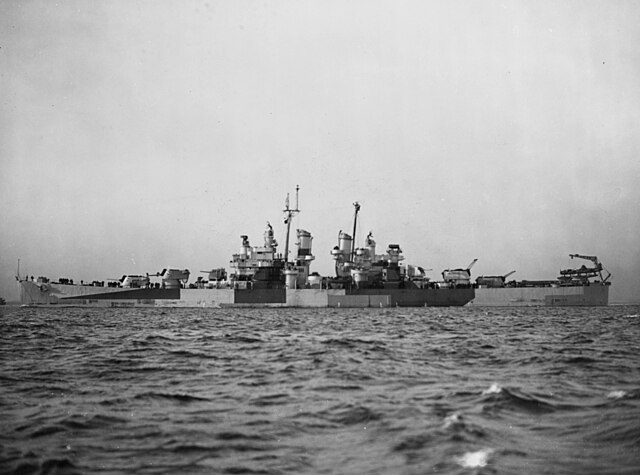 Photo: The U.S. Navy destroyer USS Irwin (DD-794) off San Pedro, California (USA), 25 February 1944 Photo: The U.S. Navy destroyer USS Irwin (DD-794) off San Pedro, California (USA), 25 February 1944 Pacific War Pacific WarBURMA-INDIA (Tenth Air Force): In Burma, 8 B-25s and 4 P-51s attack bridges at Meza, Sinthe, and Natmauk, causing light damage to the bridges and destroying 3 locomotives and several railroad cars. 91st Fighter Squadron, 81st Fighter Group, arrives at Karachi, India from Italy; they will be equipped with P-47Ds and enter combat on 16 Jun. CHINA (Fourteenth Air Force): In French Indochina, 16 P-40s attack docks, railroad yards and warehouses at Hongay; in the harbor 1 large boat is sunk and another damaged; 2 P-40's hit a cargo vessel at Campha Port, leaving it sinking; 2 others bomb and strafe Weichow Island. PACIFIC OCEAN AREA (Seventh Air Force): P-40s out of Makin bomb and strafe targets at Jaluit Atoll; B-25's from Tarawa Atoll and Abemama Island hit Mille and Wotje Atolls; B-24s from Abemama and Tarawa pound Ponape Island. SOUTH PACIFIC AREA (Thirteenth Air Force): On New Britain Island, P-39s on armed reconnaissance bomb an AA position at Monoitu, hit the Aitara area, and attack a barge in the Cape Gazelle area; 20+ B-25s hit Matupi and Rapopo; 21 B-24s and 17 P-38s follow shortly with another strike on Rapopo. SOUTHWEST PACIFIC AREA (Fifth Air Force): B-25's pound Lorengau and the Alexishafen-Madang areas and Momote Airfield and A-20s bomb airfields at Alexishafen, New Guinea. HQ 85th Fighter Wing arrives at Gusap from the US. BISMARKS In the Bismarck Archipelago, the USN's Destroyer Division 90 under Commander Edmund B. Taylor, bombards Rabaul on New Britain Island. Destroyer Squadron 12 under Captain Rodger W. Simpson, en route to bombard Kavieng on New Ireland Island and its airstrips, shipping, and fortifications, encounters a Japanese army cargo ship. In the ensuing action, destroyers USS Farenholt, USS Buchanan, USS Lansdowne, USS Woodworth and USS Lardner sink the enemy freighter. Japanese shore batteries subsequently give DesRon 12 a warm reception, damaging USS Buchanan and USS Farenholt. ALASKA (Eleventh Air Force): 3 B-24s from Shemya are over Matsuwa shortly after midnight 24/25 Feb on a photographic reconnaissance and bomb run; the mission is not completed due to weather. PACIFIC Destroyer Squadron 12 (Captain Rodger W. Simpson), en route to bombard Kavieng and its airstrips, shipping, and fortifications, encounters Japanese army cargo ship Tatsugiko Maru. In the ensuing action, destroyers Farenholt (DD-491), Buchanan (DD-484), Lansdowne (DD- 486), Woodworth (DD-460), and Lardner (DD-487) sink the enemy freighter at 02°46'N, 150°42'E. Japanese shore batteries subsequently give DESRON 12 a warm reception, damaging Buchanan and Farenholt, 02°20'S, 151°02'E. Submarine Hoe (SS-258) attacks Japanese convoy at the mouth of Davao Gulf, 75 miles south of Davao, P.I., sinking fleet tanker Nissho Maru, 05°50'N, 126°00'E and damaging fleet tanker Kyokuto Maru, 05°38'N, 126°00'E, south of Davao Gulf. Submarine Rasher (SS-269) sinks Japanese army cargo ship Ryusei Maru, 07°55'S, 115°15'E and merchant cargo ship Tango Maru, 07°41'S, 115°10'E off north coast of Bali. Submarine Tang (SS-306) continues pursuit of Japanese convoy engaged the previous day, and sinks fleet tanker Choko Maru west of Saipan, 15°46'N, 144°10'E.
|
|
lordroel
Administrator
Posts: 68,061 
Likes: 49,462
|
Post by lordroel on Feb 26, 2023 7:38:52 GMT
Day 1630 of World War II, February 26th 1944Eastern FrontThe Soviet offensive continues in northern Russia as the Red Army takes Rorkhov. Continuation WarThis night 600 Soviet bombers attack Helsinki for the third time in three weeks. From 6.45 pm until 5.10 am next morning over 500 Soviet planes try to penetrate the Finnish air-defences. Several bombers make more that one sortie, the Finns estimate that there's more than 1000 sorties. Massive fires break out destroying large sections of the city. The Soviets loose only 3 aircraft. Since the two previous attempts ten and twenty days ago, the defences had been strengthened further, and there's 15 heavy AA-battalions defending the city. Majority of bombers are unable to reach their targets, and only 18 people are killed at Helsinki. MTB Hurja 5 and Patrol Boat VMV 8 are destroyed in Helsinki bombing while in dock. Photo: Helsinki University main building after the bombing Battle of the Atlantic Battle of the Atlantic 'U-66' attacked the convoy STL-12 about 130 miles west of Takoradi and reported one ship sunk and another damaged. However, the only ship hit and sunk was the 'Silvermaple' (Master William Candlish Brydson). The master, five crew members and one gunner were lost. 47 crew members, nine gunners and one passenger were picked up by HMS 'Kildwick' (Z 06) (Lt P. Pannell) and landed at Takoradi on 27 February. Photo: HMS Kite (U87) on anti-submarine patrol with the 2nd Escort Group. HMS Kite joins in the depth charge attack and is dwarfed by the column of water which rises six-times her height. Captain Walker's 2nd Escort Group, consisted of the sloops, HMS Starling (U66), Kite, HMS Wild Goose (U45), HMS Magpie (U82) and HMS Woodpecker (U08), with the escort carriers HMS Activity (D94) and HMS Nairana (D05). In January 1944 it left from Liverpool with orders to protect convoys and intercept U-Boats in the Atlantic just southwest of Ireland. By their return in February 1944 they had managed to sink 6 U-boats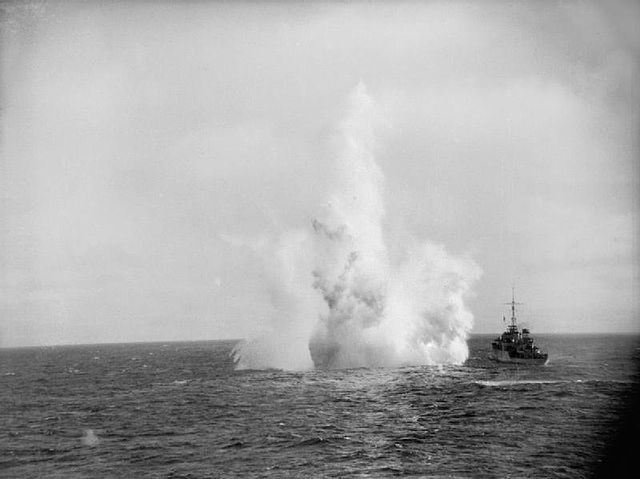 Battle of the Mediterranean Battle of the Mediterranean Weather limits US Twelfth Air Force operations severely, but P-47's hit shipping N and S of Velaluka, Yugoslavia. United KingdomPhoto: A US tank officer points out the target to senior Allied commanders during a gunnery demonstration by 33rd Armoured Regiment, US 3rd Armoured Division, at West Down artillery range in Wiltshire, 26 February 1944. Left to right: Air Chief Marshal Sir Arthur Tedder, General Dwight D Eisenhower and General Sir Bernard Montgomery Pacific War Pacific WarBURMA-INDIA (Tenth Air Force): In Burma, 15 B-25s and P-51s demolish warehouses in Naba and Hopin, attack bridges at Yeu, Bawgyo and Tantabin, and strafe railroad cars and tracks at Tangon, Namyao, and Pyintha; the Tantabin bridge is rendered unusable while approaches of the Ye-u and Bawgyo bridges are damaged. CHINA (Fourteenth Air Force): 11 B-25s from Nanning, China attack targets at Tourane, French Indochina, destroying 5 warehouses and a hangar at the airfield and a locomotive and 4 buildings at the railroad yard. PACIFIC OCEAN AREA (Seventh Air Force): B-25s from Tarawa Atoll and Abemama Island attack Wotje and Jaluit Atolls; P-40s from Makin bomb and strafe targets on Mille Atoll. 27th and 38th Bombardment Squadrons (Heavy), 30th Bombardment Group (Heavy), based on Nanumea begin operating from Abemama and Makin respectively, with B-24s. SOUTH PACIFIC AREA (Thirteenth Air Force): P-40s join USN fighters in covering a USN dive bomber strike on Vunapope supply and shipping facilities; 22 B-25s, with fighter support, follow up with the day's second strike on Vunapope; shortly afterwards, 17 P-38s strike the same target; 12 P-39s bomb and strafe Monoitu, Ruisei, Makapeko and Mawareka. SOUTHWEST PACIFIC AREA (Fifth Air Force): B-24s bomb Wewak and Momote; B-25s, along with P-39s, hit the Madang-Alexishafen area and A-20s hit Angorum. ALASKA (Eleventh Air Force): XI Bomber Command (Air Striking Group Task Group 90.1) is directed to conduct armed photographic reconnaissance missions in the Kurile Islands, day or night, as weather permits. HQ 28th Bombardment Group (Composite) moves from Adak to Shemya. PACIFIC Submarine Gato (SS-212) attacks Japanese convoy Wewak No.20 as it proceeds along the Palau-Hollandia track, and sinks passenger-cargo ship No.3 Daigen Maru about 140 miles northwest of Hollandia, 01°51'N, 139°00'E. Narita Maru rescues over 700 of the 1,200 troops being transported in No.3 Daigen Maru. Submarine Grayback (SS-208) is damaged by land-based Japanese naval aircraft, East China Sea, 25°47'N, 128°45'E.8 Motor torpedo boat PT-251 runs aground during action with Japanese barges in southern Empress Augusta Bay; and is then sunk by shore battery, Solomons, 06°30'S, 155°10'E. USAAF B-25s (14th Air Force) attack shipping in port of Tourane, French Indochina, sinking Vichy French surveying vessel Astrolabe and dredging ship Gilmot, 16°04'N, 108°13'E. Vichy officials consider Astrolabe a total loss, given the absolute impossibility of raising her with the means available in French Indochina.
|
|
lordroel
Administrator
Posts: 68,061 
Likes: 49,462
|
Post by lordroel on Feb 27, 2023 3:53:25 GMT
Day 1631 of World War II, February 27th 1944Eastern FrontTwelve He 111s of I./KG 4 and 14 He 111s of I./KG 27 made a dusk attack on Kirovgrad North airfield. After the bombs were dropped, 2 fires and one explosion south of the runway were observed. Hits were recorded on the runway, hangers and the southern part of the airfield. Air War over Europe Major General Elwood R Quesada (reappointed Commanding General IX Fighter Command on 21 Feb) receives authority to revive the IX Fighter Command (existing only on paper since creation of the IX Air Support Command) on a temporary basis as an operational HQ to function as a Combined Control Center with RAF 11 Group at Uxbridge, England, where Fighter Command will prepare operations orders for Ninth Air Force fighter and fighter-bomber groups. Quesada retains command of the IX Air Support Command. Italian CampaignLight cruiser 'Philadelphia' (CL-41) carries out seven gunfire support missions off Anzio. In Italy, A-36s attack Littoria and Guidonia Airfields and Ladispoli dock area; rail cars NE of Rome are also attacked; P-40s follow up with a raid against Littoria and hit trucks and other targets in the area; weather prevents other operations by the Twelfth Air Force. Photo: Captain W Guest-Gordons, Intelligence Officer with No. 2 Infantry Brigade, examines a German Panzerfaust anti-tank weapon, Anzio, 27 February 1944 Pacific War Pacific WarBURMA-INDIA (Tenth Air Force): In Burma, 30+ P-51s and A-36s and 2 B-25s hit ammunition dumps near the Kamaing-Walawbum road, warehouses, railroad and power facilities, bridges, and targets of opportunity in the Ye-u and Tindeinyan areas. CHINA (Fourteenth Air Force): In French Indochina, 4 B-25s fly a sea sweep from Vinh to Nam Dinh, bombing the Nam Dinh distillery and railroad yards; no ships are sighted. 8 P-40s hit the railroad bridge at Puchi, China, rendering it unusable. PACIFIC OCEAN AREA (Seventh Air Force): A-24s and P-40s from Makin pound Jaluit and Mille Atolls, while B-25s from Abemama Island hit Wotje and Mille Atolls; B-24s from Makin and Tarawa bomb Ponape Island. SOUTH PACIFIC AREA (Thirteenth Air Force): 16 P-39s strafe barges and other targets of opportunity along the SW coast of Bougainville Island throughout the day. Vunapope is attacked by 21 B-24s and 24 B-25s (both forces supported by fighter escorts) and by 14 P-38s; P-40s and USN fighters cover a USN dive bomber strike on Lakunai AA positions. 3 P-38s strafe a radar station at Cape Saint George. SOUTHWEST PACIFIC AREA (Fifth Air Force): Colonel Jarred V Crabb becomes Commanding General V Bomber Command. 30+ B-24s, with P-40 support, hit airfields at Boram, Wewak, and Tadji, 27 B-25s hit the Hansa Bay area, and over 30 A-20s attack Alexishafen and Marakum village with RAAF Vultee Vengances attack Alexishafen. Vengance A27-83 is lost. 30+ other B-25s attack Momote, Lorengau and other targets. P-39s maintain armed reconnaissance over New Britain. Lost on a reef is SS President Grant. NEW GUINEA CAMPAIGN Photo: Near Alexishafen,New Guinea. In flight, Vultree Vengeance dive bombers aircraft of NO. 24 squadron RAAF from an air raid on the Japanese-held airstrip on the North coast of New Guinea, February 27 1944 GILBERT AND MARSHALL ISLANDS CAMPAIGN Covered by large infantry landing craft LCI(L)-24, Army units carry out unopposed occupation of the Magine Islands. Photo: U.S. Marine Corps Vought F4U-1 Corsairs of Marine Fighter Squadron 113 (VMF-113) on Engebi Island, Eniwetok Atoll, Marshall Islands, in 1944. VMF-113 began operating from Engebi on 27 February 1944 as part of the 4th Base Defense Air Wing PACIFIC Submarine Cod (SS-224) sinks Japanese army cargo ship Taisoku Maru west of Halmahera, 02°00'S, 127°40'E. Submarine Trout (SS-202) sinks Japanese cargo ship Aki Maru east of Formosa, 22°40'N, 131°50'E. Submarine Grayback (SS-208) sinks Japanese cargo ship Ceylon Maru in the East China Sea, 31°50'N, 127°45'E.
|
|
lordroel
Administrator
Posts: 68,061 
Likes: 49,462
|
Post by lordroel on Feb 28, 2023 4:02:50 GMT
Day 1632 of World War II, February 28th 1944Eastern Front The Allied convoy JW-57 - 42 merchant ships and a tanker - arrives safely at Murmansk having sunk two U-boats but lost the destroyer HMS 'Mahratta'. Air War over Europe 8 RAF OTU Wellingtons carried out leaflet operations to France without loss. US Eighth Air Force Missions 237, 238 and 239 are flown today against targets in France; 7 B-17s are lost. Heavy clouds cause over half the bombers dispatched to return without bombing. 49 of 81 B-24s hit the Ecalles sur Buchy V-weapon sites; 1 B-24 is damaged. Escort is provided by 61 P-47s. 258 B-17s are dispatched against V-weapon sites in the Pas de Calais; 109 hit the primary target, 10 hit a road junction E of Yerville, 7 hit a rail siding SW of Abbeville and 6 hit targets of opportunity; 7 B-17s are lost and 75 damaged; casualties are 5 WIA and 63 MIA. Escort is provided by 81 P-38s, 94 P-47s and 22 P-51s; 1 P-38 is damaged beyond repair; the P-51s claim 1-0-0 Luftwaffe aircraft on the ground. 5 of 5 B-17s drop 250 bundles of leaflets on Amiens, Rennes, Paris, Rouen and Le Mans, France at 2023-2055 hours without loss. 180 US Ninth Air Force B-26s attack NOBALL (V-weapon) targets and Rosieres-en-Santerre, France. Bad weather makes bombing difficult and causes 34 other B-26s to abort. Italian CampaignThe second offensive from Anzio begins. The attack fails to break through. Four German divisions launch attacks against the beleaguered forces at Anzio driving down the Cisterna-Anzio road. The US 3rd Division beat back the attacks. In Italy, B-25s attack Canino landing ground, but clouds prevent accurate bombing and most bombs fall W and SW of the main target area; A-36s attack airfields at Littoria, Guidonia and Marciglialia. P-47's hit motor vessels and a tug off Dubrovnik, Yugoslavia and targets of opportunity inland. Photo: De Havilland Mosquito FB Mk VI of No. 487 Squadron RNZAF based at Hunsdon, Hertfordshire, 28 February 1944 United StatesPhoto: A U.S. Navy North American PBJ-1D Mitchell (BuNo 35094) in flight near the Naval Air Test Center Patuxent River, Maryland (USA), on 28 February 1944 United StatesPhoto: A U.S. Navy North American PBJ-1D Mitchell (BuNo 35094) in flight near the Naval Air Test Center Patuxent River, Maryland (USA), on 28 February 1944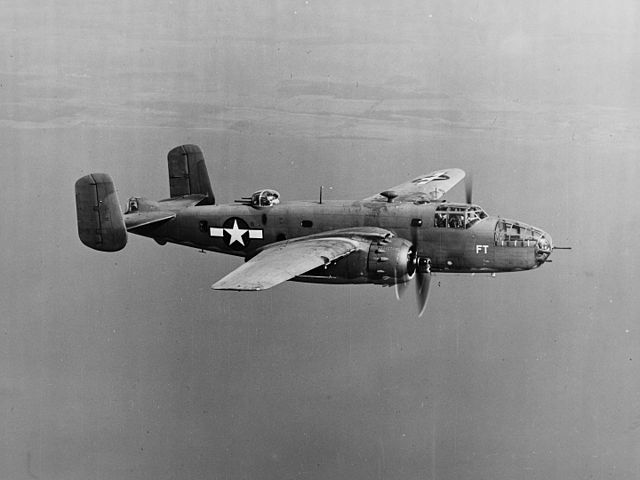 Pacific War Pacific WarBURMA-INDIA (Tenth Air Force): In Burma, 6 B-25s hit bridges and trains between Pintha and Kinu; 1 bridge is damaged and several boxcars are destroyed; 13 B-24s bomb the marshalling yard at Mandalay and targets of opportunity at Akyab, Monywa, and Pakokku; P-51s, A-36s and P-40s attack bridges, radio stations, supply dumps, bivouacs, troop concentrations, railroad by-passes, AA positions, and other targets at Seton, Sinkan, Ye-u, Kawlin, Loilaw, Namkwin, Shaduzup, and the Mogaung-Kamaing area. CHINA (Fourteenth Air Force): 6 P-40s on armed reconnaissance strafe the airfield at Myitkyina, Burma. PACIFIC OCEAN AREA (Seventh Air Force): P-40s from Makin strafe and bomb the runway and radio installation on Mille Atoll; B-25s from Tarawa Atoll pound the airfield on Wotje Atoll. SOUTH PACIFIC AREA (Thirteenth Air Force): On New Britain Island, 22 B-25s, with fighter escort, pound Rabaul; 9 minutes later 12 P-38s glide-bomb Rabaul; 2 minutes afterward 11 B-24s pound the same target; 6 other B-24s bomb Rapopo; P-40s and US Navy fighters escort USN dive bombers in a strike on Vunapope; P-39s attack Monoitu Mission. 394th Bombardment Squadron (Heavy), 5th Bombardment Group (Heavy), based on Guadalcanal Island with B-24s, begins operating from Munda, New Georgia Island. SOUTHWEST PACIFIC AREA (Fifth Air Force): In New Guinea, 23 B-24s and 39 A-20s thoroughly pound the Hansa Bay area. Nearly 20 other B-24s bomb Nubia and Awar Airfields. In preparation for the Allied landing, 50+ B-25s and B-24s pound Momote, Lorengau and other targets. 80th Fighter Squadron, 8th Fighter Group, moves from Dobodura to Cape Gloucester with P-38s. Lost is B-24D "Milk Run/Hit Parader" 42-41087. ALASKA (Eleventh Air Force): 3 B-24s from Shemya search for enemy shipping; 1 B-24 crashes during takeoff, the others find nothing. NEW GUINEA CAMPAIGN Photo: Admiralties Invasion: U.S. Navy Vice Admiral Thomas C. Kinkaid (left center) with General Douglas MacArthur (center) on the flag bridge of the light cruiser USS Phoenix (CL-46) during the pre-invasion bombardment of Los Negros Island, at the east end of Manus Island, 28 February 1944. At right is Colonel Lloyd Labrbas, acting aide to General MacArthur. Note the 40 mm quad gun mount in the background PACIFIC Destroyer Abner Read (DD-526) is damaged by grounding off eastern New Guinea, 08°44'S, 148°27'E. Submarine Sand Lance (SS-381) sinks Japanese transport Kaiko Maru just east of Musashi Wan, off Paramushiro, Kurils, 50°20'N, 155°26'E, but is later damaged when she runs aground off Paramushiro. Submarine Balao (SS-285), in attack on Japanese convoy, sinks army cargo ship Akiura Maru and transport Sh_h_ Maru about 90 miles northwest of Manokwari, New Guinea, 00°06'N, 132°53'E.
|
|
lordroel
Administrator
Posts: 68,061 
Likes: 49,462
|
Post by lordroel on Mar 1, 2023 3:48:46 GMT
Day 1633 of World War II, February 29th 1944Eastern FrontOne of the finest commanders in the Red Army, Marshal Nikolai Vatutin, is killed in an ambush by Ukrainian nationalist partisans while en route to the Soviet 60th Army. Vatutin, who had played a vital role in last year's battle at Kursk and in clearing the Ukraine, was fired on as he drove with his staff to visit front-line troops. His attackers are Ukrainian nationalists who went over to the Germans in the hope that they would establish a Ukrainian state. Now they fight both Germans and Russians. Vatutin will be sorely missed by the Red Army, It was he who, with Konev, engineered the destruction of the German pocket at Korsun. Georgi Zhukov, has taken over command of the First Ukrainian Front. Map: A map of the Nikopol–Krivoy Rog Offensive Continuation War Continuation WarThe whole of Finland is waiting for the Diet, the Finnish parliament, to decide whether or not to agree to the Russian terms for the cessation of hostilities. These terms include territorial concessions similar to those laid down by the Russians after the "Winter War" of 1939-40, but they do not require unconditional surrender as preliminary to peace talks. The main reasons that the Finns are not taking up the Soviet terms are the amount of reparations the Soviets are demanding ($600 million in 1938 US Dollars; economic experts consulted stated that it was impossible to pay in the schedule), and the very short time given to expel or intern the German forces from country coupled with the rapid demobilization of the Finnish Army (it was feared that the Soviets would use this as an excuse to occupy Finland). In a secret session the Finnish parliament votes the cabinet the powers to continue the peace-feelers with the Soviet Union. Air War over Europe US Eighth Air Force Mission 240: 218 of 226 B-17s hit aviation industry targets at Brunswick, Germany and targets of opportunity; 1 B-17 is lost and 54 damaged; casualties are 4 WIA and 10 MIA. Escorting are 61 P-38s, 346 Eighth and Ninth Air Force P-47s and 147 Eighth and Ninth Air Force P-51s; 2 P-38s are lost and 1 damaged, 2 pilots are MIA; the P-47s claim 1-0-0 Luftwaffe aircraft, 1 P-47 is lost and 1 damaged, 1 pilot is MIA; 1 P-51 is lost, the pilot is MIA. US Eighth Air Force Mission 241: 38 of 48 B-24s hit the V-weapon site at Lottinghen, France without loss. Escorting are 79 Eighth and Ninth Air Force P-47s; 1 is lost and the pilot is MIA. US Eighth Air Force Mission 242: 5 of 5 B-17s drop 250 bundles of leaflets on Orleans, Lille, Reims, Cambrai and Chateauroux, France at 2025-2121 hours without loss. 19 US Ninth Air Force B-26s bomb a coastal gun position and nearby Breck-sur-Mer Airfield, France. 216 B-26s abort a mission against 8 V-weapon sites in France because of total cloud cover over the targets. 15 RAF Mosquitos to Düsseldorf and 1 to a flying-bomb site at Sottevaast, 20 OTU sorties. 1 OTU Whitley lost. Italian CampaignThe Allies fend off a German attack on their right flank at Anzio. Bad weather prevents the Germans from continuing their attacks at Anzio, but heavy artillery fire hits hard. In Italy, B-26s bomb the main and satellite airfields at Viterbo and several targets of opportunity along the W coast; B-25s bomb troops and gun positions W of Cisterna di Roma while A-20s hit concentrations to the S; P-40s and A-36s strike at troop concentrations along the N perimeter of the Anzio beachhead; other P-40s hit barracks and railroad yards at Littoria and a tank concentration S of Cisterna; P-47's (with British aircraft) hit Giulianova railway station and shipping off Dubrovnik, Yugoslavia; fighters maintain patrol over the Anzio beachhead. United StatesPhoto: Launch of the U.S. Navy destrpyer escort USS Carter (DE-112) at the Dravo Corporation in Wilmington, Delaware (USA), on 29 February 1944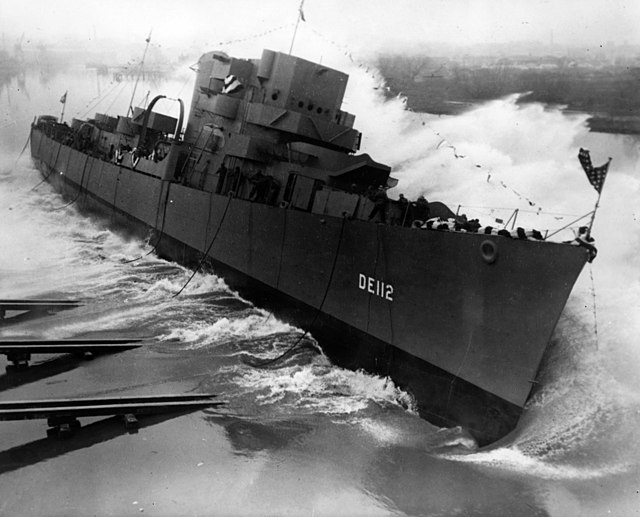 Pacific War Pacific WarBURMA-INDIA (Tenth Air Force): In Burma, 7 B-25s knock spans out of 2 bridges N of Taungtha and damage bridges S of Myingyan and between Panaing and Mahlaing; 7 B-25s and 4 P-51s bomb a radio station at Sinkan, score near misses on a bridge below Kawlin, and knock out 2 bridges in the Ye-u area. 40+ P-51s, A-36s and P-40s hit a supply area S of Seton, camp and stores near Mogaung (at Pagoda Peak), and railroad station at Myitkyina. CHINA (Fourteenth Air Force): In China, 23 B-24s pound the warehouse area at Yoyang, causing several fires and secondary explosions; 12 B-25s bomb Yoyang railroad yards; 16 P-40s provide support; 2 B-25s on a sweep of the NE China coast sink 3 sampans and damage a merchant ship at Siachwan Tao; 6 P-40s bomb and strafe ammunition dumps at Kunlong; 12 P-38s and P-51s sink a large motor launch NE of Anking, strafe barracks and 3 tugs in the Teian area, hit barracks NW of Nanchang and strafe railroad installations at Yangsin; 4 P-40s hit a barracks W of Nanchang; 2 B-25s sink a large river craft on the Yangtze River near Chiuhsienchen and damage 2 more nearby. PACIFIC OCEAN AREA (Seventh Air Force): B-24s bomb Maloelap, Mille and Wotje Atolls; B-25s hit Jaluit and Mille Atolls; P-40s attack Mille Atoll. SOUTH PACIFIC AREA (Thirteenth Air Force): 23 B-25s, with USN fighter escort, pound the Rabaul area; later 12 P-38s hit targets in the same area. 16 AAF fighters, along with 16 USN fighters, hit targets of opportunity throughout S Bougainville and Shortland. Numerous other fighters, in forces of varying sizes, attack barges and scattered targets of opportunity throughout the N Solomons, Bismarck Archipelago, and waters in between. NEW GUINEA CAMPAIGN TG 76.1 (Rear Admiral William M. Fechteler), comprising nine destroyers and three high speed transports, lands Army troops (First Cavalry Division) on Los Negros Island, Admiralty Islands, in Operation Brewer, continuing the strategic encirclement of Rabaul. The two light cruisers and four destroyers of TF 74 providecover and bombard Japanese positions on Los Negros and Manus. Photo: First Wave at Los Negros, Admiralty Islands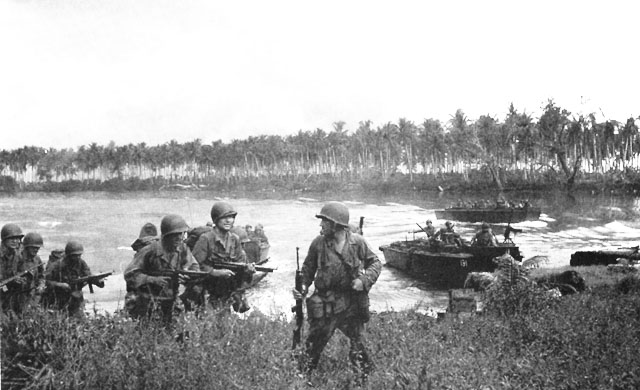 Map: Situation on Los Negros on the night of 29 February 1944 Map: Situation on Los Negros on the night of 29 February 1944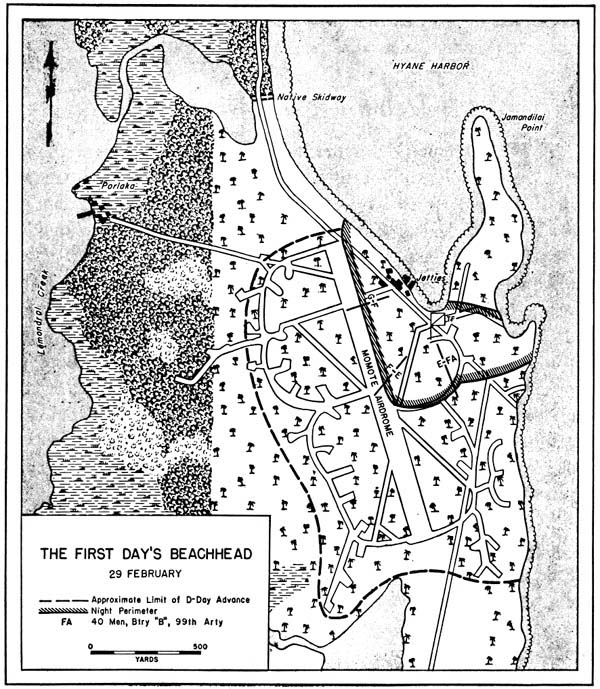 (Fifth Air Force): Allied amphibious forces land on Los Negros, temporarily taking Momote Airfield and then falling back to the beachhead on Jamandilai Point; weather prevents full air support but 7 B-24s and 8 B-25s manage to attack enemy positions and guns; Other B-24s and A-20s hit Erima, Wewak, Tadji, Awar, and Hollandia. Lost is B-24D 42-72899 and B-25D "BAR-FLY" 41-30593. Destroyer Division 44 (Commander James R. Pahl) bombards wharf areas and installations at Rabaul. PACIFIC PB4Y-1s (VB 108, VB 109, VD 3), flying from Apamama and staging through Kwajalein and Roi, carry out low-level bombing raid on Japanese installations on Wake Island. Submarine Rock (SS-274), while making a night surface attack on a convoy of three Japanese freighters, is damaged by surface gunfire off Nansei Shoto Islands, 25°33'N, 130°42'E, and is forced to terminate her patrol. Submarine Sargo (SS-188) attacks Japanese convoy and damages army cargo ship Uchide Maru about 120 miles west of Palau, 08°57'N, 132°52'E (see 1 and 2 March 1944). Submarine Trout (SS-202) attacks Guam-bound Japanese convoy about 625 miles east of Formosa. She sinks army transport Sakito Maru southeast of Okinawa, 22°40'N, 131°50'E, and damages transport Aki Maru, but Trout is later sunk, most probably by Japanese destroyer Asashimo, 22°40'N, 131°45'E.9 USAAF B-25s sink Japanese merchant tow boat Choka Maru on the Yangtze near Chiuhsienchen. USAAF B-24s damage Japanese cargo ship Narita Maru 45 miles east of Hollandia.
|
|

















































































